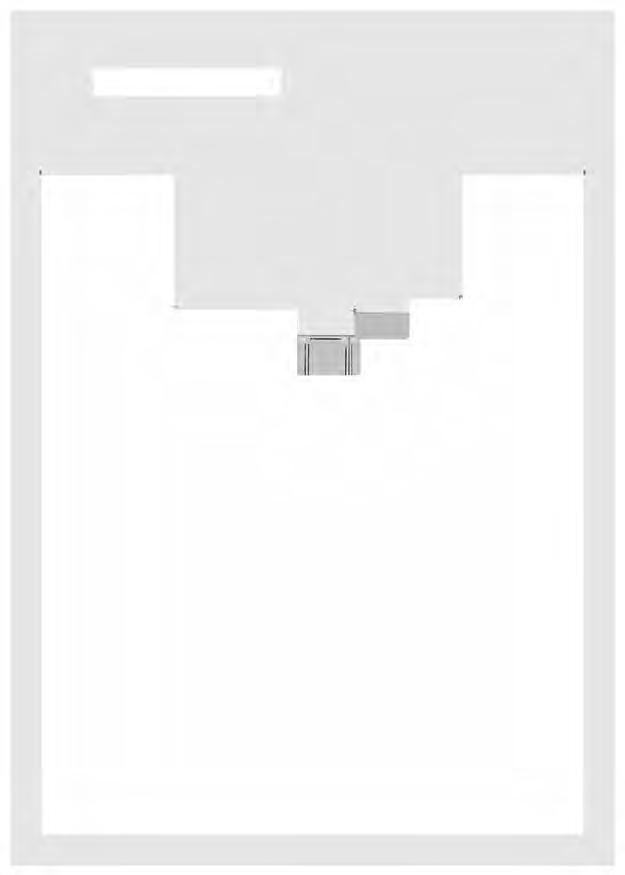Interview: Samir Cherif, Senior Director and Regional Business Head at HID MEA
Feature Story
Biometrics in Healthcare
Openness and Security in One Package

ISNR Director
Ali Ayoub:


Interview: Samir Cherif, Senior Director and Regional Business Head at HID MEA
Feature Story
Biometrics in Healthcare
Openness and Security in One Package

ISNR Director
Ali Ayoub:

.
With employee badge in Apple Wallet, staff and visitors can open office doors, access laptops, elevators, secure printers and much more using just their iPhone or Apple Watch. It’s another way HID is enabling secure, convenient workplace access.
Get started with employee badge in Apple Wallet at: hidglobal.com/applewallet

We help you digitalize and future-proof your buildings with a wide range of access solutions meeting your individual needs, supporting your move from the mechanical to the digital world. We are experts in access. With us, you digitalize with confidence.

can security and openness in access control be reconciled in modern healthcare institutions? The answer lies in new technologies that no longer require healthcare institutions to make unfavorable compromises between openness to


Professional media for complete security solutions
Management
Mahir Hodžić, General Manager mahir.hodzic@asmideast.com
Adis Hodžić, CEO adis.hodzic@asmideast.com
Editorial Staff
Mahir Hodžić, Editor-in-Chief mahir.hodzic@asmideast.com
Orhan Hadžagić, Associate Editor orhan.hadzagic@asmideast.com
Emily Lin, Contributing Editor Emily.Lin@taiwan.messefrankfurt.com
Mirza Bahić, Journalist editorial@asmideast.com
Nermin Kabahija, Journalist editorial@asmideast.com
Art Staff
Sanel Palislamović, Art&Design Editor sanel.palislamovic@asmideast.com
Nelmedin Kolubara, DTP&Art Design dino.kolubara@asmideast.com
Sales Amar Pap, Business Development Manager amar.pap@asmideast.com
International Sales Israel Gogol, International Sales Director Israel.Gogol@taiwan.messefrankfurt.com
International Associates Qatar – Mirsad Selimović, mirsad@techman.qa
a&s Middle East offers the latest news and insights on video surveillance, access control, intrusion detection, fire alarm, mechanical protection, man guarding, cyber security, artificial intelligence, IoT, big data, smart homes and buildings, industrial automation, information, communication technology to Middle East region professional channel players.
a&s Middle East is part of the media network of the Messe Frankfurt Ltd – Taiwan Branch, which offers several media platforms — asmag.com and a&s magazines, published in English, traditional Chinese, and three other languages, providing the most comprehensive industry trends, product, and supply chain information. The total annual circulation is approximately 515,000 copies around the globe. a&s Middle East is published 6 times a year, Jan/Feb, March/ April, May/June, July/August, Sept/Oct, and Nov/Dec.
Payment Instructions
Annual subscriptions are payable in USD, EUR, or AED. Subscription inquiries per your request.
EUR: AE340400000653005131002
Account No. 0653005131002
USD: AE070400000653005131003
Account No. 0653005131003
AED: AE610400000653005131001
Account No. 0653005131001
Copyright Statement
© Copyright by Privus Agency Ltd. All rights reserved. Any republication, copying, redistribution, or reproduction of the magazine in any form, including electronic, without the prior written consent of the publisher, is prohibited. Advertisers are solely responsible for the content of advertising material. The publisher bears no responsibility regarding possible legal, patent, content, or brand disputes of the advertiser.
Legal disclaimer
The information in this magazine has not undergone any formal testing by Privus Agency Ltd. and is distributed without any warranty expressed or implied. Implementation or use of any information contained herein is the reader’s sole responsibility. While this information has been reviewed for accuracy, there is no guarantee that the same or similar results may be achieved in all environments.
Corporate Address
Privus Agency FZ-LLC
JT010006, Al Shohada Road, Ras Al Khaimah, UAE
Tel: +971 58 983 4258
Web: www.asmideast.com
Marketing: marketing@asmideast.com
Welcome to the latest edition of a&s Middle East. In this issue, we shine a spotlight on expert voices — yes, the guiding voices that can help you navigate the intricacies of the security landscape and leverage its hidden insights to your advantage. Presented in the format of exclusive interviews, these insights will offer unique perspectives from industry experts and leaders.
First on our list are Onur Sonmez and Eman Mattie-Suleiman of Bosch, who will discuss the significance of EN and VdS-certified products in fire safety, underscoring the importance of quality, compliance, and seamless integration in mixed markets.
Next, we have Samir Cherif, Senior Director and Regional Business Head at HID Middle East and Africa, who will shed light on the growing demand for advanced security solutions in the Middle East as the intersection of technological innovation, sustainability, and convenience in the broader region.
Moving further east, we spotlight Korea’s expanding global influence in the security industry, exemplified by the impact of SECON 2024. Among the exhibitors, Suprema stands out, showcasing Korea’s contributions to security technology on the international stage.
Additionally, we examine the integration of biometrics in healthcare, addressing the balance between openness and security in access control.
Lastly, we are excited to announce ISNR 2024 as the leading regional exhibition dedicated to showcasing innovations that enhance national security, cybersecurity, law enforcement, and vital facility protection.
Through exclusive interviews and insightful features, we aim to provide you with a skeleton key to unlock numerous industry topics, offering valuable perspectives from genuine trailblazers. Next time, we might be knocking on your door.
Please visit our official website www.asmideast.com and select ‘Subscribe Now’ option under THE MAGAZINE menu.
Subscription includes all six editions.
Digital edition is FREE and readily available at the official website.



Saudi Arabia’s government plans to create a fund of about $40 billion to invest in artificial intelligence, the New York Times reported on Tuesday, citing three people briefed on the plans.
Representatives of Saudi Arabia’s Public Investment Fund (PIF) have discussed a potential partnership with US venture capital firm Andreessen Horowitz and other financiers in recent weeks, the newspaper reported.
Andreessen Horowitz and PIF governor Yasir Al-Rumayyan have discussed the possibility of the US firm setting up an office in Riyadh, according to the report.
PIF officials also discussed what role Andreessen Horowitz could play and how such a fund would work, the newspaper said, adding the plans could still change.
Other venture capitalists may participate in kingdom’s artificial intelligence fund, which is expected to commence in the second half of 2024, the newspaper said.
Saudi representatives have indicated to potential partners that the country is interested in supporting a variety of tech start-ups associated with artificial intelligence, including chip makers and large-scale data centers, the report added.

PIF and Andreessen Horowitz did not immediately respond to requests for comment from Reuters.
Last month, PIF’s Al-Rumayyan pitched the kingdom as a prospective hub for artificial intelligence activity outside US, citing its energy resources and funding capacity.
Al-Rumayyan had said the kingdom had the “political will” to make artificial intelligence projects happen and ample funds it could deploy to nurture the technology’s development. n
Under the patronage of His Royal Highness Prince Mohammed bin Salman bin Abdulaziz Al Saud, Crown Prince and Prime Minister, and Chairman of the Board of Directors of the Saudi Data and Artificial Intelligence Authority (SDAIA), the third edition of the Global AI Summit is set to take place from September 10 to 12, 2024, here, at the King Abdulaziz International Conference Center.
SDAIA President Dr. Abdullah bin Sharaf Al-Ghamdi issued a statement expressing gratitude to HRH the Crown Prince for his unwavering support for the Global AI Summit, emphasizing the pivotal role this patronage plays in advancing the national data and AI agenda, maximizing the benefits of cutting-edge technologies, and improving the Kingdom’s global standing and reinforcing its leadership position in the field.

Al-Ghamdi said in the statement: “This summit builds upon the remarkable achievements of its previous editions, in 2020 and 2022, under the gracious patronage of HRH the Crown Prince. The third edition of the summit distinguishes itself through its extensive range of topics covering diverse areas of global interest in data and AI. This is particularly significant considering the rapid progress of these technologies and their profound impact on individuals and institutions.”
The summit will cover key topics in the field of AI, such as innovation and industry trends, shaping a brighter future for AI, and cultivating an enabling environment for human talent.
Sub-themes will delve into various aspects, including local and global AI applications, the integral relationship between humans and AI, business leadership in AI, the correlation between data and applications, generative AI, AI ethics, AI processing and infrastructure, and the role of AI in smart cities.
Al-Ghamdi extended an invitation to leading AI policymakers and individuals passionate about data and innovation to participate in the upcoming summit. n
Video survelliance and security solutions for various industries, from factories to local shops.
Easy scalability
Compatible with 99% of cameras
Essential video analytics
Multiplatform (TRASSIR OS, Windows, Linux)



allows you to accurately detect objects (people, heads, cars, bicycles, etc) in the frame. When a foreign object enters the specified area, the detector generates an alarm.
uses a pre-configured database of people (residents, staff, etc.) and prevents access of undesirable people to the facility.
identifies car licence plates and allows you to track the passage of any vehicle of interest from the archive in screenshots and video fragments.

The global SCADA market size is anticipated to grow from USD 11.2 billion in 2024 to USD 16.6 billion by 2029, at a CAGR of 8.3% from 2024 to 2029, according to the latest research from Marketsandmarkets. Surging deployment of AI and IoT across manufacturing industries and increasing smart city projects pertaining to infrastructure and transportation are cited as just a few of the significant factors which drive the growth of this market.
Within the discrete manufacturing landscape, SCADA systems serve as integral tools to uphold production efficiency and meet targeted output objectives. These systems monitor and control the entire production lifecycle, from tracking units in production to managing inventory levels for just-in-time manufacturing practices. Additionally, SCADA systems play a pivotal role in orchestrating industrial automation and robotics while

concurrently monitoring processes and ensuring stringent quality control measures. As a result, SCADA offers a robust platform for the development of sophisticated, interconnected, and secure solutions that
The findings of the Allianz Risk Barometer are based on insights from 3,000 risk management professionals and leaders With the increasing digitization of the travel industry, cybersecurity concerns have become paramount. From airlines
significantly enhance the efficacy of manufacturing operations. The escalating demand for such advanced SCADA systems is anticipated to be a key driver propelling growth within the SCADA market. n
to hotels, every sector within travel is now susceptible to cyber threats. Recent incidents highlight the vulnerability of the travel sector to cyberattacks. For instance, in 2023, a major airline suffered a data breach that compromised

the personal information of millions of passengers. Similarly, hotel chains have experienced ransomware attacks, disrupting operations and compromising guest data. The consequences of such cyber incidents are significant. Beyond financial losses, there is a loss of trust among customers. When personal data is compromised, customers may hesitate to book with the affected companies in the future.
To mitigate these risks, travel companies must invest in robust cybersecurity measures. This includes implementing encryption protocols, regularly updating software, and conducting thorough employee training on cybersecurity best practices. Additionally, collaborating with cybersecurity experts and sharing threat intelligence can enhance preparedness and response capabilities.
In an increasingly interconnected world, cybersecurity must be a top priority for the travel sector. By taking proactive steps to safeguard customer data and infrastructure, companies can protect their reputation and maintain customer trust in an evolving digital landscape. n

Following Sheikh Mohammed bin Rashid Al Maktoum’s vision to position Dubai as a global technology leader, Sheikh Hamdan bin Mohammed bin Rashid Al Maktoum, Crown Prince of Dubai, presented the Dubai Universal Blueprint for Artificial Intelligence, reported state news agency WAM.
The project is attended to engage the technology’s potential to improve the quality of living.
Sheikh Hamdan said, “In 1999, Dubai commenced its journey towards the future by launching its digital transformation venture, which has continued to achieve major milestones leading to the recent unveiling of the Dubai Digital Strategy last year. We have realised record-breaking accomplishments that have established Dubai as the premier hub for billion-dollar global enterprises in the technology and artificial intelligence sectors within the region.”
He also underlined “To enhance Dubai’s global leadership, today we launch Dubai’s Universal Blueprint for Artificial Intelligence to accelerate the adoption of artificial intelligence applications, which will achieve the targets of the
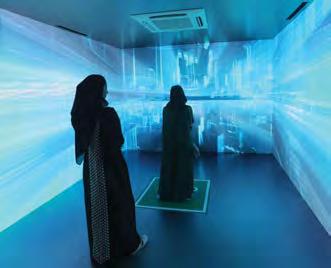
Dubai Economic Agenda (D33) by contributing Dhs100bn annually to Dubai’s economy through the digital economy
and increasing the economy’s productivity by 50 percent through the adoption of innovative digital solutions.” n
The Saudi Data and Artificial Intelligence Authority (SDAIA) offers a range of smart solutions to support developmental sectors in the Kingdom by leveraging data and artificial-intelligence (AI) technologies.
The solutions include supporting national efforts aimed at preserving the environment and natural resources and achieving a sustainable future, in line with achieving the Saudi Vision 2030 targets. This stems from its role as a national reference for data and AI in the Kingdom, covering everything related to their organization and development.
These efforts are aligned with parallel efforts by SDAIA to enhance the Kingdom’s position as a leading country in data and AI, enabling investment, innovation, and the development of technological infrastructure.
The authority aims to promote the adoption of AI in priority areas to serve national priorities, given its expertise in operations, research, and innovation in the data and AI sector.
SDAIA has dedicated its efforts to establishing the Artificial Intelligence Center of Excellence in Environment, Water, and Agri-
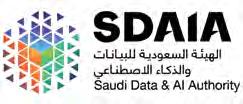
culture in partnership with the Ministry of Environment, Water, and Agriculture. It aims to innovate sustainable solutions and applications using AI in the fields of environment, water, and agriculture.
The authority aims to build a data lake containing geospatial data and global satellite images from the past thirty years, as well as to conduct studies and research that benefit the environment, water, and agriculture sectors using AI. n

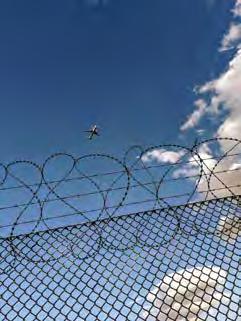
The latest report from research company Marketsandmarkets forecasts a robust growth trajectory for the global Perimeter Security market. It anticipates an increase from USD 81.4 billion in 2024 to USD 114.2 billion by 2029, reflecting a healthy Compound Annual Growth Rate (CAGR) of 7.0% during the forecast period.
The primary drivers of this growth are the escalating security concerns related to terrorism, criminal activities, and illegal immigration. Technological advancements, particularly in surveillance and detection systems such as intelligent video analytics and biometric systems, are key contributors. Additionally, the imperative to secure critical infrastructure across various sectors further propels market expansion. Regulatory requirements and the integration of Artificial Intelligence (AI) and Machine Learning (ML) technologies are also significant factors, enhancing system adaptability and effectiveness.
The Perimeter Security market is witnessing key drivers in the form of opportunities emerging from the development of smart cities, urbanization trends, and the increasing integration of Internet of Things (IoT) devices. These advancements augment monitoring capabilities, while opportunities in public-private partnerships and innovations in wireless technology and data analytics enhance system scalability and efficiency. Consequently, market expansion plays a crucial role in propelling the growth of the perimeter security sector. n
To truly embed sustainability within an organization, a comprehensive and strategic approach is essential. This includes examining the physical infrastructure, as buildings alone account for approximately 30% of global energy consumption, as highlighted by the International Energy Agency.
Many architectural and design processes already integrate sustainability considerations. The demand for green building certifications is on the rise among decision-makers in the built environment sector, as indicated by a recent survey of 4,000 professionals conducted by specialist sustainability media outlet, Edie.
However, it’s crucial to recognize that sustainability extends throughout the entire lifecycle of a building. Even during operation, design and specification decisions continue to impact ongoing sustainability performance and energy management. The selection of access solutions is one such decision that can

significantly contribute to an organization’s overall sustainability strategy. From the conceptualization phase to product procurement and the mainte-
nance, repair, or retrofitting of existing structures, choices regarding access control play a pivotal role in sustainability efforts. n
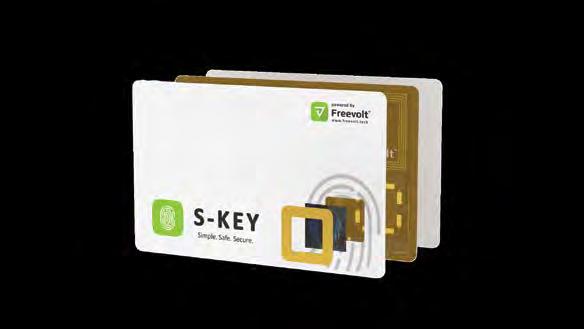
As a global forum, ISNR 2024 brings together participants to accelerate the transformation of their national security systems into components of a global defense against all types of threats, promoting proactive readiness and the collaboration-innovation axis
n By: Ali Ayoub Show Director - National Security Abu DhabiGreetings to all attendees of the eighth edition of the International Exhibition for National Security & Resilience (ISNR), organized by Capital Events, ADNEC Group.
I am honored to convene under the esteemed patronage of Lt. General H.H. Sheikh Saif bin Zayed Al Nahyan, Deputy Prime Minister and Minister of Interior UAE. ISNR stands as a focal global forum, uniting policymakers, professionals, and security stakeholders to delve into pioneering solutions and exchange invaluable insights, shaping a more fortified tomorrow.
Themed “Accelerating Transformation in the National Security Ecosystem”, ISNR 2024 is poised to delve into the forefront of national and cybersecurity domains, unveiling cutting-edge technologies while fostering a culture of knowledge dissemination among experts and practitioners. This year, we are proud to announce a significant milestone as 44% of participating companies, representing a multitude of nations, make their debut appearance, bolstering our collective efforts to mitigate both local and global threats. Embracing the ethos of collaboration, innovation, and knowledge exchange, ISNR 2024 introduces an array of novel features, including the Cyber Security Hub. This innovative platform shines a light on the transformative power of emerging technologies, underscoring our commitment to advancing the sector’s capabilities. As we embark on this journey of exploration and discovery, let us collectively chart the course towards a safer and more resilient future. Welcome to ISNR 2024, where the pulse of security innovation beats stronger than ever before. The Interpol Policing Hub binds the collective expertise and resources of National Police Forces worldwide, serving as an interactive nexus for collaboration, knowledge sharing, and innovation in global law enforcement.
ISNR Abu Dhabi 2024’s unwavering commitment to fostering innovation is epitomized by the introduction of Tech Talks, a dynamic live

The pulse of security innovation beats stronger than ever before at ISNR 2024
podcast series engaging industry luminaries on various social media platforms to dissect the latest trends in AI, cyber, and homeland security.
For those eager to explore groundbreaking innovations, the ISNR innovative Zone will showcase 15 visionary startups unveiling a spectrum of creative new technologies. Mirroring ISNR’s expansive global reach, an Emerging Enterprises showcase spotlights the distinctive capabilities of entities from newly participating countries.
Moreover, the inaugural Rabdan conference will convene a premier assembly of global specialists, offering cutting-edge insights into contemporary security challenges of paramount importance.
With robust participation from UAE government entities, ISNR’s Delegation and Networking Area stands poised to bolster and enrich local and international collaborations across the homeland security, cyber security, policing, and law enforcement domains.
As the organizers of ISNR, we extend our profound gratitude to all our esteemed public
and private sector partners, with a special acknowledgment to the Ministry of Interior and Abu Dhabi Police, whose steadfast support has significantly contributed to ISNR’s enduring success and elevated its esteemed international standing.
While it’s true that Abu Dhabi holds the distinction of being one of the safest cities globally, hosting an exhibition like ISNR in such a secure environment serves several crucial purposes: Maintaining Vigilance: Even in the safest of environments, it’s essential to remain vigilant and continuously update security measures to stay ahead of evolving threats. ISNR provides a platform to showcase the latest advancements in security technology and practices, ensuring that Abu Dhabi continues to uphold its reputation for safety.
Future Preparedness: The landscape of security threats is constantly evolving, driven by technological advancements, geopolitical shifts, and socio-economic factors. ISNR serves as a forum for anticipating and preparing for future challenges by showcasing cutting-edge innovations and facilitating discussions on emerging trends. This proactive approach ensures that Abu Dhabi remains resilient in the face of evolving security risks.
Showcasing Leadership: By hosting ISNR, Abu Dhabi demonstrates its commitment to being at the forefront of security innovation and thought leadership. It highlights the city’s proactive stance in addressing global security concerns and reinforces its reputation as a hub for excellence in security solutions and practices.
In summary, while Abu Dhabi’s status as the safest city in the world is commendable, hosting ISNR reinforces its commitment to maintaining and enhancing its security posture through collaboration, innovation, and proactive preparedness for the future. I urge you to seize the myriad networking opportunities, knowledge-sharing sessions, and innovative showcases available at the event.
I eagerly anticipate welcoming you all to ISNR 2024 on the 21st of May for an enriching and enjoyable experience. n













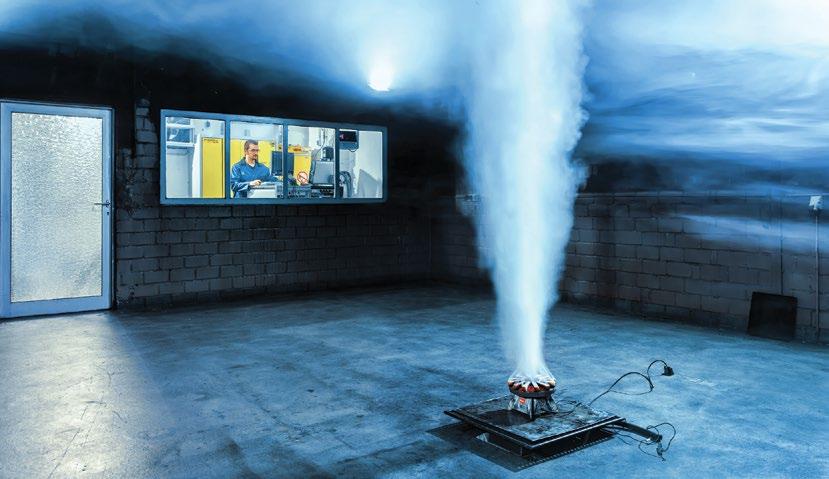
Eman Mattie-Suleiman, VdS
Onur Sönmez, Bosch Fire Alarm Systems

In this exclusive interview, Eman Mattie-Suleiman, Technical Director at VdS, and Onur Sönmez, Head of Sales and Marketing, Bosch Fire Alarm Systems, Türkiye, Middle East and Africa shed light on the importance of the adoption of EN and VdS-certified products in fire safety, emphasizing their quality, compliance, and seamless integration in mixed UL-EN markets
a&s Middle East: What are some of the key differences between the standards enforced in the EU and the building codes of practice, such as NFPA 72, commonly used in the USA, particularly regarding product requirements and testing methods for fire safety equipment??
Mattie-Suleiman: The CPR applied in the EU is like having a product passport to be able to move within the EU market. These are based on harmonized product standards which have certain requirements for a product. Some of these requirements are related to the conditions and regulations within EU countries. The NFPA 72 building code is the planning and installation code for such products which are primarily produced by the Americans for the USA. However, the NFPA 72 specifies some product requirements that are related to conditions found in the USA. The intent in both cases is the same but the method of testing and parameters may be different. For example, the temperature specified in NFPA is 0 to 49 degrees whereas the EN standards specify -10 to 55 degrees for smoke detectors but for control and indicating equipment it is -5 to 40 degrees. Also, the times the product is exposed to these temperatures differ.
a&s Middle East: According to US Building Codes, is it mandatory to be UL listed? What does NFPA 72 say about this?
Mattie-Suleiman: It is absolutely not mandatory to use ULlisted products to install products designed in accordance with NFPA 72. In fact, the NFPA 72 code clause 1.5 explicitly permits the use of equipment of the same or higher quality than described in this code. Therefore, it is undisputed that the EN 54 standards which are harmonized under CPR - both always included in VdS-Approval - are of a high level of quality and fit for use in their anticipated environment, independent from any single code of practice including NFPA 72. Clause 1.5 of NFPA 72 discusses equivalency in the context of systems, methods, devices, or appliances used in fire safety. It states that the code does not prohibit the use of systems or equipment that are of equal or better quality, strength, fire resistance, effectiveness, durability, and safety compared to those outlined in the code. However, to demonstrate equivalency, technical documentation must be provided to the authority having jurisdiction. Once equivalence is proven, the alternative systems or equipment can be approved for use.
Sönmez: Unfortunately, there is often a misconception in some markets that a tender that is NFPA 72 specified cannot be covered with an EN-certified system. Well, we have just heard from VdS that an EN solution would perfectly fulfill the requirements of NFPA 72.
a&s Middle East: Can you explain the key differences between EN 54 and UL certifications?
Mattie-Suleiman: The intent of both the UL and EN 54 product standards are similar. In other words, each product is tested in terms of functionality or sensitivity as it undergoes environmental, mechanical and electromagnetic testing, while some products such as smoke detectors also undergo fire tests. However, the actual tests and the requirements are different. The UL standards are written by USA experts whereas the EN is written mostly by experts from European countries. The development and harmonization needs of the standards take longer in Europe but they are scrutinized more intensively by experts. The

With over 27 years in fire protection since 1997, Eman Mattie-Suleiman holds a PhD in Instrumentation and Control Engineering, an MSC in Control Engineering, and a degree in Electronic System Engineering. Specializing in fire detection and alarm systems, she actively contributes to national, European, and international standards committees. Her expertise ensures the advancement and reliability of fire safety measures globally.
repeatability of tests and control of test equipment must be of a really high standard. To obtain the CE mark under the CPR, the product must also meet all relevant directives such as EMC, electrical safety, etc.
a&s Middle East: Has any independent body such as VdS looked into the compatibility of EN 54-certified products in NFPA installations?
Mattie-Suleiman: Many top sector experts have studied the NFPA 72 code and that is why VdS states with confidence that the EN 54 product approval can be allowed to be used in installation which is based on NFPA 72.
Sönmez: Bosch products are VdS specified. So, our customers can be confident that with our portfolio they can perfectly comply with all NFPA 72 requirements. In fact, we have successfully conducted several projects that were originally specified for NFPA 72. I can recall an example of a well-known textile and apparel manufacturer operating in Lahore, Pakistan that we concluded recently.
The EMC testing under the EN is of high standards and second to none

a&s Middle East: Is there any cooperation between VdS and other laboratories in Europe?
Mattie-Suleiman: Yes. Under the European Fire and Security Group (EFSG), we have established cooperation with other European laboratories. Any test house can apply to join the EFSG but they have to meet the high standard imposed by this group.
a&s Middle East: The UL and VdS Mutual Data Acceptance agreement was recently announced. What will change with this Agreement?
Mattie-Suleiman: In a similar way to the EFSG, the agreement is based on mutual acceptance of tests and this will be projectbased and assessed case by case. The implication is that manufacturers wishing to gain VdS and UL quality marks based on EN 54 standards can now achieve it with less testing.
a&s Middle East: In the past, it was also announced a similar agreement with FM Global. Could you comment on this collaboration?
Mattie-Suleiman: There is an agreement for the fire detection and alarm products based on EN 54 between VdS and FM. Manufacturers are free to apply.
a&s Middle East: Now, a question that we often have from stakeholders: does the EN certification guarantee a high level of EMC immunity? Why is this important?
Mattie-Suleiman: The EMC testing under the EN is of high standards and second to none. The EMC is one of the most challenging tests for fire product manufacturers and most test houses experience a high level of failure in the initial testing. With today’s technology and possible interference, you want to guarantee that your product performs in the correct way and does not cause nuisance or risk to the occupiers of the building and fire service personnel.
Sönmez: Bosch systems comply with the EN standards concerning EMC. But we go even beyond that. We want to avoid any disruption to production and other operations caused by electromagnetic disturbances. That is why we offer an eSmog feature in our AVENAR 4000 fire detectors. What does this mean? Well, the Bosch detector offers additional EMC protection beyond regular EN requirements and, on top of that, measures disturbance
values. If they are too high, the detector location can be improved. It greatly reduces the risk of false alarms, subsequent downtime, and unnecessary evacuations.
a&s Middle East: How do EN standards and, for example, VdS certifications fit regional variations in regulatory requirements and market preferences, particularly in regions with diverse certification standards?
Mattie-Suleiman: In many regions of the world, the dominant and accepted standards are EN (e.g. in Europe) or UL (e.g. in the USA) or a mix of both standards (e.g. in the Middle East). Some regions of the world such as China, India, and Australia, have their own standards but if you look into these standards, there are a lot of similarities, and some are really based on ISO standards with some variations. For example, if you take the control and indicating equipment, the AS7240-2 standard is called up in Australia. This standard is in fact based on ISO 7240-2 which itself is based on EN 54-2.
Having a product tested against a specific standard is one thing but to ensure its fit for a specific site and application, you may want to consider other factors such as climate conditions, risk assessment, etc.
a&s Middle East: What strategies do you recommend for companies looking to promote the use of EN and VdS-certified products in markets dominated by UL standards?
Mattie-Suleiman: We encourage companies to invite our experts to support and cooperate with those who specify the approval need on the value that is offered by EN standards and the VdS quality mark.
Sönmez: Exactly, this is the way to go. Therefore, Bosch is now putting a big effort to run communication activities to inform but also to train main stakeholders in mixed UL-EN markets. They must be aware of the many open possibilities for EN solutions. Specifically, we are collaborating with trade magazines and associations,

We encourage companies to invite our experts to support and cooperate those who specify the approval need on the value that is offered by EN standards and the VdS quality mark

Having earned a Bachelor of Engineering in Electric and Electronic Engineering from Bahçeşehir Üniversitesi and a Master of Engineering in the same field from Anadolu Üniversitesi, Onur Sönmez brings a strong academic foundation to his career. With over 12 years at Bosch Security and Safety Systems, he is now Head of Sales & Marketing for Türkiye and the Middle East & Africa. His long-term knowledge in these markets equipped him with profound expertise, particularly in regulatory aspects of fire alarm systems under EN and UL regulations.
running digital campaigns & webinars, and also organizing f2f events with consultants and system integrators in the Middle East, ASEAN, India, and Latin America. For this, we work closely together with VdS to communicate about the high standards of a VdS certification.
a&s Middle East: From your perspective, how do you anticipate the adoption of EN solutions in the UL-EN mixed markets?
Sönmez: Today, most of the mixed regions are very UL-driven. Projects are often NFPA 72 specified and, as mentioned earlier, many automatically interpret that these projects are only
Once the consultants, system integrators, and end customers learn about the high quality and compliance of EN standards, they open up to EN solutions
Having a product tested against a specific standard is one thing but to ensure its fit for a specific site and application you may want to consider other factors such as climate conditions and risk assessment
open for UL solutions. Nevertheless, we can see that once the consultants, system integrators, and end customers learn about the high quality and compliance of EN standards and in our case, about the benefits of our Bosch solutions, they open up to EN solutions. This way we are increasing the number of successful projects and the number of happy customers, which also calls for more projects.
Let me share some benefits or special features offered by Bosch to help designers transform an originally UL project into EN. Firstly, our AVENAR panels are pretty unique when it comes to their functionality. It means, panel meet several UL functional requirements such as audible distinguishing of fire & fault signals, signaling line circuit separation or flexibility to add modules that offer auxiliary monitored outputs. That, followed by the newest technological achievements such as 7’’ color touchscreen or an integrated Ethernet switch, makes the overall state of art solution that satisfy even most demanding users.
Then I’d like to highlight our detection range. For instance, AVENAR 4000 point type detectors that do not only meet high electromagnetic requirements given by EN 54 standards, but exceed them offering extraordinary robustness in 10-50kHZ frequency range and live measurements of the EMC value in the field. That results in high reliability and reduce total cost of ownership, minimizing false alarms.
Our signaling devices frequently offer ISO 8201 driven signaling tone and comes with luminous intensity information (cd), that let the planners to easily follow NFPA 72 requirements. Additionally, many of them offer unique power supply concept, meaning a build-in batteries that can reassure 30-minute alarm functionality even upon double loop breakage.
Last but not least, I’d like to mention our AVENAR all-in-one signaling device, which is a single-point solution for applications when both visual and audible alarm signaling is required. It can be used with or without a detector, and also it doesn’t need extra power supply to work.
On top of the product features, we also have good delivery times, advanced tools shortening project design and commissioning time, competitive pricing and 3 years warranty with an advance replacement procedure.
Check this out, learn more and You will fall in love unique offer.
a&s Middle East: What is the one key takeaway you would like people to remember from this interview?
Mattie-Suleiman: Your optimal back-up in any emergency is ensured by the top reliability of VdS-approved and so also ENcertified products.
Sönmez: As we learn from VdS, the EN solution would perfectly fulfill the requirements of NFPA 72. Therefore, since Bosch products are VdS specified, our customers can be confident that our portfolio perfectly matches all NFPA 72 requirement. n
In an interview with a&s Middle East, Vincent Deery, CEO of 3DX-Ray, unveils the Axis-CXi, a groundbreaking cabinetbased X-ray system that aims to reshape the world of security screening with its advanced materials discrimination technology
n By: Orhan Hadžagić editorial@asmideast.coma&s Middle East: Can you give us a brief background on 3DX-Ray?
Deery: 3DX-Ray is a UK designer and manufacturer of security X-ray systems. The company was founded in 1996 to introduce X-ray images in a 3D format to the security world. For almost 25 years 3DX-Ray has been developing its X-ray products to support the growing demands of the security market. We first worked with the aviation sector in the 90s, and we have decades of experience in the EOD world with the military, police forces, and NGOs. We have installations across the globe with a 3DX-Ray system supplied in over 78 different countries.
a&s Middle East: Why did you introduce the Axis-CXi?
Deery: As I mentioned, 3DX-Ray has been manufacturing X-ray systems for many years starting with conveyor systems. 3DX-Ray has also been supplying mail screening or cabinet-based X-ray systems for many years. However, we wanted to introduce our higher technologies and improved capabilities into the cabinet system market, which has been largely stagnant for the past 20 years. We saw a gap in the market for a more sophisticated and contemporary solution. Hence, the Axis-CXi was born.
a&s Middle East: What makes the Axis CXi special?


Deery: The Axis-CXi has a class-leading inspection volume but with a small overall footprint. This means that the unit can be used not only for checking incoming mail for threats carried in the postal system but also as a front-of-house service for checking bags, laptop cases, or any item up to the size of a carry-on bag. So, the unit has a dual purpose.
a&s Middle East: This is a significant step and a change in the functionality of the system. Could you tell us more about it?
Deery: The significant functionality improvement is the introduction of aviation standard materials discrimination. In the EOD world and the aviation sector for
many years the operators have been presented with images that are not just black and white - they are presented with color images. These color images are called materials discrimination images. The color images that the operator views provide more data about the item they are assessing. The colors accurately represent the material composition of the items in the scan. This enables an operator of our AxisCXi systems to have the same level of data that an EOD operator or a screener in an airport would have. This is a step change, something that has not been available in cabinet systems until now.
The materials discrimination images show organic material colored orange and me-
The technology we introduced is from our line scan systems which is proven and based on decades of experience in the EOD world

tallic material in blue and if it is a mixed material it is colored green. Our system represents these materials correctly and verifies them according to the standards used by the aviation sector. This added information is extremely helpful for an operator. In airports and the EOD world, this information is widely used. Until now with the introduction of the Axis-CXi, the cabinet-based inspection did not have this level of technology, and only viewed monochrome or pseudocolor images, making the assessment of potential threats more difficult and less reliable.
a&s Middle East: Have you used the technology that already exists in the marketplace?
Deery: No, the technology we introduced is from our line scan systems which is proven and based on decades of experience in the EOD world. Our technology is used in portable systems that an EOD operator takes out in the field to inspect suspect devices often in a high-pressure environment. We use this expertise and associated advanced imaging capability in the Axis-CXi product.
a&s Middle East: Would you describe it as a key advantage of the CXi?
Deery: Yes, the imaging capability and functionality tend to be of a higher level than those used in the existing cabinet systems. We have taken the high-level technology deployed in these mobile systems and made it simple and easy to use for less highly trained operators in the cabinet market.
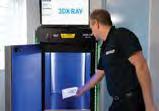
We have designed this new product completely from scratch and there were no pre-concepts or pre-conditions to the design
a&s Middle East: What were the considerations behind the unique design of the CXi?
Deery: Yes, we have designed this new product completely from scratch and there were no pre-concepts or pre-conditions to the design. We looked at what the user requirements were and then we designed our product from that information without any assumptions. We also wanted to harmonize the look of the unit with its environment. We see it being used in prestigious buildings such as hotels or corporate headquarters and its design must therefore complement the aesthetics of these more glamorous settings. We have not only made it look attractive, but we have also made it easy and convenient to use. It has a simple touchscreen interface and a loading height designed by experts in the field of ergonomics. We’ve made the inspection chamber suitable for loading not just mail or postal items but also laptop cases or carry-on cabin bags. We have also placed it on wheels so that it can be easily and quickly relocated. In summary, it looks good, is easy to use, and can be quickly moved into place.
a&s Middle East: How diverse is the potential deployment of your product and what other sectors or environments could benefit from its security features?
Deery: We think this unit can be deployed very widely. You mentioned hotels and offices, but our partner base is already talking to clients such as banks, embassies, education establishments, courts, prisons, and many other buildings with a security risk or public use. n
The significant functionality improvement is the introduction of aviation standard materials discrimination
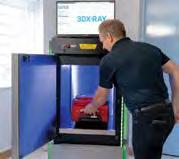
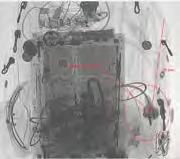


In an exclusive interview with a&s Middle East, Samir Cherif, Senior Director and Regional Business Head at HID Middle East and Africa, discusses the growing demand for advanced security solutions in the Middle East, highlighting the intersection of technological innovation, sustainability, and convenience in shaping the region’s security landscape
n By: Orhan Hadžagić
editorial@asmideast.coma&s Middle East: As the Senior Director and Regional Business Head at HID Middle East Africa, how do you perceive the current market landscape, especially in the context of the Middle East region?
Cherif: The Middle East region is undergoing substantial infrastructure development, from smart cities to new commercial complexes and buildings, as well as the expansion of critical infrastructure. The region is also experiencing rapid technological advancements, with increasing digitalization across various sectors. With this, we’re witnessing a growing demand for advanced security solutions, particularly in sectors such as government, finance, and industry. As the Middle East continues to invest in infrastructure development and these smart
city initiatives, there’s a heightened focus on enhancing security measures to safeguard critical assets and information. Added to this is the requirement for greater convenience and the adoption of new technologies which provide an enhanced end-user experience, without compromising on security. We’re also seeing a notable trend toward sustainability among global companies based in the Middle East, driving a heightened emphasis on environmentally friendly practices and solutions within the security sector.
a&s Middle East: Could you elaborate on HID’s strategy for expanding its presence in countries such as UAE and Saudi Arabia, and how it aligns with the company’s broader objectives?
Cherif: First and foremost, we prioritize understanding the unique needs and challenges of these markets through in-depth market research and direct

engagement with key stakeholders. This allows us to tailor our product offering to meet the specific needs of customers in the region. By continuously enhancing our product portfolio and capabilities, we’re able to maintain our position as a trusted partner for organizations seeking advanced security solutions.
Aligned with this, is our deep understanding of the market. As we transition into 2024, we forecast continued strong growth in the region and, in line with this, we have strategically allocated additional
resources on the ground, to support customers effectively.
Further, we also have a network of strategic partnerships with local distributors – these partnerships enable us to extend our reach and footprint while providing on-the-ground support to our customers.
a&s Middle East: In terms of access control, how is HID approaching the industry in 2024, particularly considering the trends and growth observed in the previous year?
Cherif: Our Middle East business saw the largest percentage growth in 2023 and we expect that to continue this year. Our global presence and local offices, in conjunction with our newest logistics center in Ireland—recently created to better support Europe and the MEA regions—will enable us to meet this growth with increased efficiency and capacity.
a&s Middle East: What are some emerging trends in identity solutions that businesses and governments should pay attention to, especially in the context of
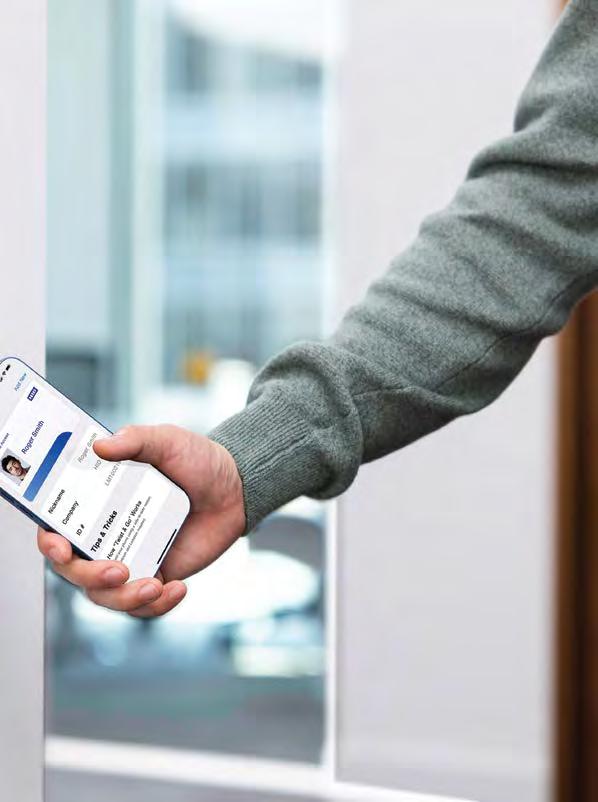
Our Middle East business saw the largest percentage growth in 2023 and we expect that to continue this year
The Middle East region is undergoing substantial infrastructure development, from smart cities to new commercial complexes and buildings, and the expansion of critical infrastructure
mobile solutions and biometric authentication?
Cherif: With the rise of digital technologies, such as multi-factor authentication and artificial intelligence, digitization of identities is growing rapidly. We are seeing this in the region, where our customers have been adopting a mobile-first focus, leveraging technologies such as mobile access, to achieve heightened security, improved operational efficiency, and more convenience. And end users appreciate the convenience that comes with authenticating themselves via a de -
vice they already carry (their mobile phone) so we see this trend continuing to grow even more in the future.
Companies are also paying more attention to the balance between going digital and being sustainable. This focus on sustainability is connected to using data and resources efficiently. Access systems are no longer just about building entry and exit. For example, HID Mobile Access technology can be integrated with smart building systems to manage facilities more sustainably with identity positioning. By sharing pertinent occupant data, the smart building system can optimize operational efficiency by adjusting temperature settings accordingly, particularly in underutilized areas of the building. It also provides valuable information regarding space utilization and, cou-
pled with our low-energy readers, contributes to achieving green building goals by reducing overall energy consumption.
a&s Middle East: HID experienced significant growth last year. What are the key factors driving this growth, and how does the company plan to sustain it in the coming year?
Cherif: One of the most important factors is digital transformation. We have all experienced how the introduction of smartphones has shifted how we navigate through our everyday lives. HID Mobile Access represents this shift in terms of accessibility: organizations need efficient and easy ways of managing building access whilst grappling with today’s more strategic challenges such as hybrid work or delivering against stringent environmental, social, and governance (ESG) goals. So, with sustainability being a core concern for many organizations, as well as for HID, technological innovations that integrate security with intelligent building management systems are taking off.
The need for flexibility is also a driving factor pushing demand. With companies having to operate under tight budgets, it is important to provide solutions that make the migration from older systems to digital IDs easy. There are millions of HID readers installed already that are capable of using HID Mobile Access – either instantly or via a simple on-site upgrade –and so many end users are able to adopt mobile access quickly and efficiently without updating their hardware. We also work with customers to provide a free trial of HID Mobile Access to help demonstrate the value that it can bring across an organization.
This year, we aim to maintain this growth momentum, focusing on expanding in the Middle East, particularly in Saudi Arabia and the Gulf region. We are increasing our resources in the region, and we have all of our operations tightly adjusted for on-time production and deliveries. Finally, our network of partners and distributors, along with our regional logistic center, will ensure all customers get what they need.
a&s Middle East: Could you shed light on HID’s focus on helping customers understand the benefits of merging security and convenience through HID Mobile Access, especially in the context of digital wallets?
Cherif: Mobile devices have become essential components of most people’s daily lives, not just for their intrinsic features but also for the invaluable, convenient benefits they provide. And people always have their devices with them. Using them to access places and move around different parts of the building is a logical next step. Most recently, the integration of employee badges into digital wallets became possible. While digital wallets have been around for payment transactions for some time, today they can do so much more. Digital wallets hold medical prescriptions, travel documents, driver’s licenses, ID cards, insurance information, and employee badges. With employee badges in digital wallets, employees can access office doors, elevators, turnstiles, multifunction printers, and much more using just their smartphones or smartwatches. Other than enterprises, digital IDs and wallets are also
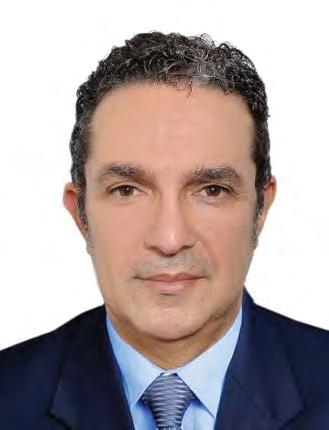
prevalent in the education sector where universities and schools are enabling students and staff to add their IDs or badges to digital wallets on mobile devices. This allows them to easily access buildings on campus and purchase meals using their mobile devices.
The great part is that employee badges in digital wallets integrate into existing access control systems, they are simple to distribute and manage and take advantage of the built-in security features of the devices.
a&s Middle East: How do you perceive the changing security requirements and policies in hybrid work environments, and what role does HID play in addressing these challenges?
Cherif: The rise of hybrid work models has been beneficial for us, accelerating the adoption of our mobile access solutions in a way we couldn’t have predicted.
The rise of hybrid work models has been beneficial for us, accelerating the adoption of our mobile access solutions
Flexibility has become paramount with hybrid models blurring the lines between office and home. Employees need seamless access remotely or in the office for a few days. This is where mobile access shines, offering secure and convenient entry via smartphones or wearables.
While some building owners worry about reduced space utilization due to hybrid models, we see a different opportunity. Mobile access, as well as our recently launched Identity Positioning, offers valuable data insights on building usage patterns, allowing for optimized space allocation and resource management. This can lead to cost savings and even the creation of flexible co-working spaces.
a&s Middle East: The integration of employee badges into digital wallets offers several benefits. Could you elaborate on how this integration enhances security, convenience, and sustainability for businesses?
Cherif: This digital experience not only increases operational efficiency but also helps reduce the number of plastic cards that users use and lose, which has a posi-
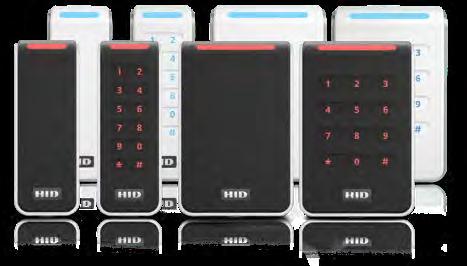
a&s Middle East: HID has traditionally been known for physical access solutions. How has the company transitioned to focus on identity and access management, particularly in the realm of passwordless authentication?
Cherif: We are in the business of trusted identities, so our mission is to ensure all authorized individuals are accessing and being granted the appropriate level of permissions to systems and resources. As you can imagine, this is not just to physical locations via key cards, but also to critical digital resources like banking apps or even immigration systems. In today’s digital world, passwords are increasingly vulnerable to cyber threats. HID recognizes this, and passwordless authentication is our answer. While multi-factor methods that include passwords might still have a role, the future lies in multiple and stronger layers of identity verification like fingerprints, facial recognition, or PINs.
tive impact on sustainability and security. A great example is in the higher-education sector, where universities are taking a mobile-first approach in lieu of plastic cards by offering mobile IDs with the ability to open doors, check out library books, make cafeteria purchases, and more. In addition, the future generations of employees, such as Gen Z, will drive demand for mobile access as they are generally more environmentally conscious and en-
gaged with the issue of climate change than previous generations. Today, Gen Zers are the biggest users of mobile and related applications, followed by Gen Alpha the expected “super-users” of mobile.
a&s Middle East: What are some of the key advantages of adopting HID Mobile Access with digital wallets, particularly in terms of reducing costs, improving efficiency, and enhancing workplace security?
Our customers have been adopting a mobile-first focus, leveraging technologies such as mobile access, to achieve heightened security, improved operational efficiency, and more convenience
Cherif: In terms of reducing costs, adopting HID Mobile Access with digital wallets eliminates the need for producing and distributing physical badges, reducing associated costs such as printing, maintenance, and equipment. This shift to digital credentials also aligns with sustainability goals by reducing plastic waste. Additionally, with badges in digital wallets, card distribution, and management across the entire company is streamlined as there’s no need to print physical cards for employees or guests, who can access places quickly and safely. Finally, workplace security is enhanced because of two main features: biometric authentication used to unlock the devices, such as facial and fingerprint, adds an extra layer of security to verify the user’s identity; and the encryption technologies used in digital wallets ensure the secure storage and transmission of those digital credentials.
a&s Middle East: How does the HID Origo cloud platform facilitate remote management and updating of credentials, and what certifications validate its secure infrastructure?
Cherif: The cloud platform is where enrollment, provisioning, and authorization of credentials happen, and is a critical element of a robust access control system. HID Origo Mobile Identities is a cloudbased platform that provides integrated

access control solutions through a seamless, scalable infrastructure. Origo improves access control delivery by helping organizations efficiently manage a range of activities around access control, including user enrollment, credential provisioning, lifecycle management, and data privacy. Administrators can easily manage multiple locations or even multiple identities on a single mobile device. The portal simplifies HID mobile access set-up for administrators and end users alike, with convenient, fast provisioning and deprovisioning that can be completed in a few simple steps.
More than this, is also Origo can be seamlessly integrated into existing access control software, through our APIs and SDKs, to provide a single solution for the management of your site and the people in it.
a&s Middle East: Considering the shift towards digital credentials and sustainability goals, what role do digital employee ID cards play in helping companies meet their climate change objectives?
Cherif: Digitalization and sustainability are major driving forces for HID, and we’re heavily invested in aligning with
these trends. Mobile access is a prime example. By virtualizing credentials, we eliminate plastic waste from traditional cards and reduce shipping needs, minimizing our environmental footprint. This also aligns with the growing consumer preference for convenience and security offered by mobile solutions. Furthermore, we launched sustainable physical credentials made from bamboo, catering to workplaces and applications where personal devices are restricted. This innovative option further reduces plastic consumption and provides a responsible alternative for environmentally conscious customers. This is also the first in a range of card credentials we will be launching.
Also, our signature line of readers, Signo, offers intelligent power mode, which can reduce electricity consumption by over 40% per reader – particularly significant for large sites that may have 1,000+ readers.
However, our commitment to sustainability extends beyond product development. We optimize our logistics and internal processes to minimize resource usage and emissions. The combination of innovative products, strategic operations, and
Adopting HID Mobile Access with digital wallets eliminates the need for producing and distributing physical badges, reducing associated costs such as printing and maintenance
environmental awareness positions HID as a leader in the access control industry for the digital and sustainable future.
a&s Middle East: Can you discuss HID’s channel community in the Middle East and North Africa regions? How does your company support its regional channel partners?
Cherif: Our channel ecosystem plays a pivotal role in extending our reach, delivering solutions, and providing support to customers across the region.
One way we support these partners is through comprehensive training and certification programs. We understand the importance of equipping our partners with the knowledge and skills necessary to effectively sell and support our solutions. Therefore, we offer a range of training programs, both online and in-person, that cover product knowledge, technical skills, sales training, and more.
Channel partners are crucial to our success in the region as they are the ‘storefront’ of our business. In line with this, we have a specially created partner program that provides access to sales and marketing materials, training, and resources – all free of charge.
In addition, we provide our partners with access to sales and marketing resources, including collateral, co-branded materials, and campaigns, to help them effectively market our solutions to their customers. This collaborative approach ensures our partners have the tools
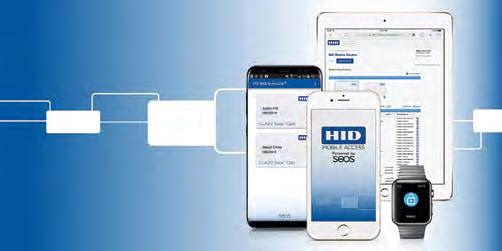
a&s Middle East: Will Physical Access Control in the business sector be marked by future-proof solutions and contactless experiences?
Cherif: Definitely – that’s why HID Mobile Access is growing so much in the Middle East and globally. Mobile access utilizes smartphones and other mobile devices as credentials for building entry and access control, so users no longer need to carry physical cards - simplifying access for both employees and visitors. In addition, users have enhanced security due to the multiple protocols and additional encryption layers it offers, plus the fact that people are more guarded over access to their mobile device and quickly notice if it’s missing.
and support they need to succeed in the market.
Overall, our approach to partners is centered on collaboration, enablement, and mutual success – reflecting our commitment to building strong, long-lasting partnerships that deliver value to customers and drive collective business growth.
a&s Middle East: How will HID ensure that its solutions remain adaptable to evolving customer needs and industry trends, especially in the dynamic landscape of physical security technology?
Cherif: HID goes beyond simply providing out-of-the-box access control solutions.
By
We create a secure and connected ecosystem that is adaptable to evolving technologies and new cultural norms. Our commitment to innovation fuels pioneering solutions like mobile credentials in digital wallets.
Our heavy investment in research and development is closely tied to the latest security and data privacy standards to ensure our products not only stay ahead of the curve but comply with strict industry requirements.
This means we actively participate in shaping the future of secure access control by contributing to industry standardization bodies across every global region.
This ensures our solutions are futureproof and compatible with emerging technologies.
Finally, unlike competitors who may lock you into proprietary systems, HID prioritizes flexibility and security. Our open-architecture platform seamlessly integrates with existing infrastructure, regardless of manufacturer, empowering businesses to choose the best fit for their needs.
a&s Middle East: Can you share any insights into HID’s future plans and initiatives in the realm of access control and secure identity issuance, particularly in emerging markets such as the Middle East?
Cherif: Looking ahead, HID’s plans for emerging markets like the Middle East likely involve continuing to educate customers on the benefits of mobile access. This goes beyond simply opening doors; it can provide contactless, secure access to a wide range of devices and services. Imagine employees using a mobile ID for building access, then clocking in at a time-and-attendance terminal, using cashless vending machines, or accessing printers and computers – all with their smartphones. Additionally, HID Mobile Access can extend to parking locations, visitor management systems, and other applications. By promoting the versatility of mobile credentials, HID can empower businesses in the Middle East to streamline workflows, enhance security, and embrace a more convenient and sustainable access control approach. n
A country known for its hi-tech, cinema, and music, South Korea’s international influence now extends to the security industry, as evidenced by the impact of the latest SECON 2024
n By: Mirza Bahić mirza.bahic@asmideast.comSECON 2024, held from March 20-22 in Seoul, emerged as South Korea’s premier security exhibition. Since its inception, it has made significant strides not only in the local market but also beyond the borders of Korea, impacting the global security industry. As the 23rd edition of SECON and the 12th year of eGISEC, the event provided a rare opportunity for stakeholders to converge physical and cyber security solutions under one roof.
With 396 exhibitors from 13 countries and 25,763 visitors from 30 countries, occupying 28,000 square meters of exhibition space, SECON 2024 showcased its prominence in the security industry. Featuring 1479 booths and over 100 sessions across 25 tracks, the event provided a comprehensive platform for knowledge exchange and networking. The focus of this year’s SECON edition was “Safer World with AI”. In addition to featuring physical security products like CCTV, access control, and biometrics, as well as infrared sensors such as PIR and PID for social security, the exhibition offered a diverse range of security

solutions for both online and offline use. This included antivirus software designed to combat various hacking and cybercrime scenarios, including ransomware attacks, along with EDR, NDR, and XDR systems capable of addressing endpoint and network security threats in a cohesive manner. Moreover, cloud security and AI-powered security solutions were highlighted, providing a comprehensive suite of security options for various applications, both online and offline. Finally, match-making programs facilitated connections between buyers and vendors, while special booths catered to
diverse themes like online business platforms and security job fairs. As such, it’s no wonder that SECON 2024 attracted attention not only from local stakeholders but also from global players. With its global reach and comprehensive coverage of security solutions, SECON 2024 played a pivotal role in bolstering the Korean security market. As this market is known for the impact that transcends the geographical borders of Korea, it’s worth exploring it as a harbinger of the trends that will shape the future of security on a global scale.

Korean security companies are expanding their footprint in the Middle East, capitalizing on the region’s burgeoning market and demand for advanced security solutions. For instance, Suprema secured a significant project in Neom, Saudi Arabia, supplying access control solutions for the construction of Neom Hospital. Additionally, Korean cybersecurity startup SecuLetter signed a partnership agreement with Best IT, a cybersecurity consulting and solution provider in Saudi Arabia. This collaboration underscores the growing collaboration between Korean and Middle Eastern companies in addressing cybersecurity challenges and deploying state-of-the-art security solutions. As the Middle East emerges as a key market for security technologies, Korean companies are poised to play a pivotal role in shaping its security landscape and addressing evolving threats.
The security market in South Korea is experiencing robust growth, fueled by technological advancements and increasing awareness of cybersecurity threats. With AI technologies taking center stage, experts anticipate a steady expansion in both the physical and cyber security segments. During the pandemic, South Korea experienced a significant shift in its digital environment, driven by the widespread adoption of remote work solutions and digital transformation. This transition has accelerated the country’s journey toward AI transformation, leading to rapid growth in the security industry as a whole. The numbers more than corroborate this: in 2023, Korea’s physical security market grew by 4.3% to $4.5 billion and is expected to further increase by 3.5% to $4.7 billion in 2024. Similarly, the cyber security market expanded by 5.8% in 2023 to $2.4 billion, with a projected growth of 4.4% to $2.6 billion in 2024. Consequently, South Korea’s security industry surpassed $7 billion in 2023, with an anticipated outcome of $7.3 billion in
the current year, maintaining a steady growth trajectory.
With an expected annual growth rate (CAGR) from 2024-2028 of 11.76%, the projected market volume should reach US$1.9 billion by 2028. In terms of demand, the country’s security market is witnessing a surge in demand for advanced biometric authentication systems. Driven by technological advancements and local trends, South Korea places significant emphasis on cybersecurity to protect its digital infrastructure. As a leading player in industries like electronics and information technology, South Korea prioritizes cutting-edge solutions in the sectors that are closely related to the security industry. For instance, the average revenue per installed smart home in South Korea is estimated to be US$168.90.
The Korean government has demonstrated its commitment to fostering the security industry as a cornerstone of national economic development. Recently,
the government unveiled plans to promote physical security as one of the nextgeneration industries, aligning with its broader strategy to enhance global competitiveness in the information security sector. Designating cybersecurity as one of the 12 national strategic technologies, the government has laid out a roadmap focusing on data security, AI integration, digital vulnerability analysis, network security, cloud security, and industrial convergence security technologies. By supporting R&D efforts, fostering collaboration between public and private entities, and providing incentives for innovation, the government aims to sustain the high growth trends observed in the domestic security market, exceeding an average annual growth rate of 12.8% over the past three years.
South Korea boasts a robust ecosystem of security companies, with industry giants such as Hanwha Vision, IDIS, and Suprema leading the charge. Hanwha Vision leverages world-class imaging technology to provide comprehensive security solutions for various sectors, including access control and intruder detection. Similarly, IDIS stands out as a global leader in digital surveillance solutions, with a presence in over 50 countries and a reputation for innovation and quality. Suprema, renowned for its AI-based security solutions, has also secured significant projects worldwide. These companies exemplify South Korea’s prowess in developing cutting-edge security technologies and driving innovation on a global scale.
The upcoming SECON event, SECON 2025, scheduled for March 19-21, 2025, at the Kintex Center in Seoul, South Korea, will build upon the success of its predecessors. Given the success of the latest event, it is evident that these exhibitions will serve as key platforms for industry stakeholders to strategize their growth and innovation plans. With a focus on ensuring safety and security beyond the borders of South Korea, the next SECON is primed to continue shaping the trajectory of the security industry, both domestically and internationally. n
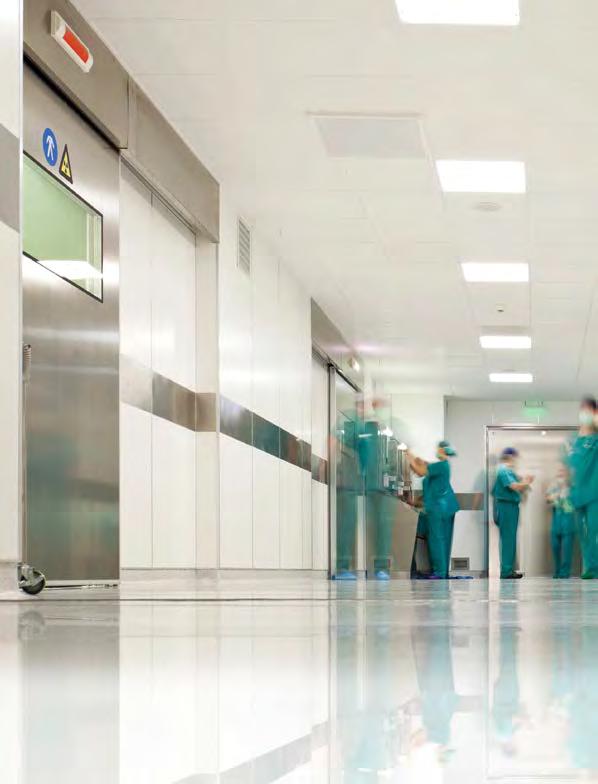
How can security and openness in access control be reconciled in modern healthcare institutions? The answer lies in new technologies that no longer require healthcare institutions to make unfavorable compromises between openness to patients and their safety
n By: Mirza Bahić editorial@asmideast.comAccess control in the healthcare sector is burdened with a paradox. In other sectors, this aspect of security restricts access to protected areas without the need for special accommodation for users, except for maintaining basic accessibility. On the other hand, hospitals, health centers, and clinics are places that maintain a practice of round-theclock openness and accessibility to a wide range of users.
Hospitals are institutions for the protection and preservation of life, which is why both patients and medical staff rightfully expect the same dedication to be applied to protecting their privacy and security. At the same time, most medical institutions must also uphold the principle of accessibility because you must be able to seek and receive help at any time of the day. On the other hand, an overly intrusive and strict system of patient and
visitor control can cause discomfort and lead them to seek a more comfortable environment elsewhere.
However, the threats to these institutions are real and frequent enough to warrant systematic attention. Security issues in healthcare institutions encompass a wider range of risks, from compromising health through injuries, abductions, and blackmail to threats of violence, compromising patient privacy, data theft, equipment and drug theft, and the presence of unwanted visitors. Ultimately, hospitals are places where human lives are often at

stake, and additional forms of endangering lives and physical integrity are the last thing patients, staff, and management want to have as an additional concern. In addition to patients, the protection of medical staff, including doctors, nurses, and maintenance workers, is no less important, with the first two groups being the most frequent targets. According to research, healthcare workers are five times more likely to face violence in the workplace compared to employees in other sectors, underscoring the urgency of addressing these security challenges.
Data from the World Health Organization shows that nearly 40% of healthcare workers experience physical violence in the workplace. In the United States alone, violence against medical staff increased by 67% between 2011 and 2018. Operating rooms, examination rooms with expensive equipment, and staff lounges therefore need to be strictly separated from areas open to the public such as waiting rooms and triage stations. Access control must exist here as an invisible yet equally robust barrier that separates two worlds.
The work regime in hospitals is one of the reasons why flexibility in access control in these institutions is as important as the level of protection. Healthcare is a roundthe-clock business that is inherently dynamic and unpredictable. Staff schedules often follow unforeseen patterns that rely not only on shifts but also heavily depend on emergencies, epidemics, natural disasters, and the like. Therefore, modern access control systems in these facilities
If you use the internet itself become Healthcare workers are five times more likely to face violence in the workplace compared to employees in other sectors

So-called self-certification or sole reliance on a manufacturer’s compliance statements is

must offer flexibility to adapt to the unpredictable work regime while simultaneously allowing smooth access to specific zones for authorized personnel. Additionally, there is the unique institution of patient visits that the access control system user must take into account. Risks to staff and patients are reduced by limiting potential threats through managing entry approval and access to facilities and rooms, thereby encouraging the creation of a safer environment. This is achieved through simplified shift coordination, access restriction based on user groups and visitation times, and advanced visitor management.
Modern healthcare institutions are also places where valuable and expensive property is kept. This includes medical examination equipment, medications in hospital pharmacies, and patient’s medical records that are treated as confidential documentation. All of this emphasizes the need for access control solutions that will be flexible in terms of supporting seamless interaction between staff and
patients, but also uncompromising when it comes to protecting valuable property in these institutions.
Compromising the security of property significantly impacts the quality of healthcare and the social reputation of healthcare providers. Incidents range from theft of items such as stethoscopes and thermometers to the loss of much more valuable medical equipment. Culprits are typically staff members, patients, or contractors.
The International Association for Healthcare Security and Safety (IAHSS) stated in its 2022 study that intrusion into medical centers is the third most common form of crime in these facilities after disturbances of public order and assaults. According to this data, due to inadequate access control, thefts in hospitals increased by almost 6% per 100 beds compared to just one year earlier. However, theft of medical equipment is a much more complex problem than the mere loss of items. While these criminal acts can indeed cause significant material damage to healthcare institutions, the ‘invisible’ healthcare and service expenses are magnified as organizations often pass on the incurred costs to future patients. Additionally, this form of security threat
has an intangible component through the potential to directly harm patients themselves in cases where equipment theft occurs in the most urgent medical situations. Protecting hospital property through improved access control is achieved by implementing an advanced system that will protect medical equipment and patients’ personal belongings based on the application of privilege hierarchy, visitor management, and event logging.
In healthcare, access control encompasses physical access to facilities such as hospital wards and administrative offices, as well as digital access to electronic health records and other sensitive information.
Ensuring adequate access control to data in healthcare institutions is essential for protecting patient privacy. Equally important is compliance with regulations such as the Health Insurance Portability and Accountability Act (HIPAA) in the United States or the General Data Protection Regulation (GDPR) in the European Union. These regulations require the implementation of measures
The theft of equipment also has an intangible component through the potential to directly harm patients themselves if it occurs during emergency medical situations
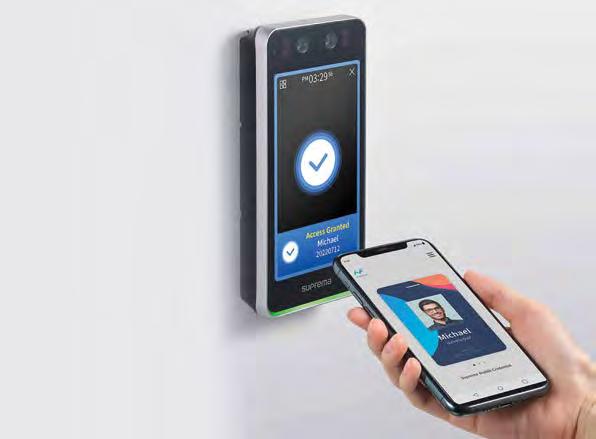
such as user authentication, encryption, role-based access control (RBAC), and logging to restrict access to patient information based on the principle of least privilege. This protects the confidentiality of patient health information and reduces the risk of data breaches through unauthorized access.
What does the healthcare sector require from access control?
Given all the mentioned factors, access control systems in modern medical facilities must address a much broader spectrum of security needs related to the specificity of their operations. One of the fundamental prerequisites is a sophisticated systemic design that will serve both public and secure spaces equally well. Hospitals need access control solutions that seamlessly integrate into their architectural layout while offering robust security measures. Reliability is another crucial aspect because hospi-
tals are institutions that do not operate on a nine-to-five schedule – instead, they are open 24/7 to provide timely care to every patient.
Access control in healthcare is further complicated by the fact that clinical centers often comprise complexes with multiple buildings. Access control must, therefore, be integrated with other systems used in these facilities, such as video surveillance or fire alarms. As these systems play a crucial role in emergencies, access control systems in hospitals must ensure seamless integration with fire alarms and video surveillance. In emergencies, access control systems must also support rapid evacuation procedures, with the ability to offer real-time customized updates for first responders in the field.
In other sectors, building spaces are often inaccessible to the general public, so their protection with a standard cre-
dential system usually yields satisfactory results. Conversely, medical facilities typically have numerous access points open to the public, with a limited number of security staff and a policy of general openness to all seeking assistance.
A temporary option is to reduce access points to avoid security incidents such as unauthorized access, patient elopement, or abductions. Unfortunately, this is only possible in the initial phase of building construction, as the facility’s capacities inevitably expand over time. Since denying access to the main entrance is not an option, hospitals must prioritize only the most sensitive areas and implement appropriate role-based access control. For example, patients should not be able to freely access the hospital pharmacy or rooms containing the medical records of other patients.
Privilege-based access control can reduce the likelihood of theft by means of having an appropriate visitor processing system. In case of unforeseen accidents, access point usage records are important as a source of valuable data

to help identify perpetrators. Additionally, it is useful to categorize access points in the facility into standard and securitysensitive areas, departments, or zones where there is a higher likelihood of security issues. These areas require stricter access control if it is assessed that unauthorized intrusion could seriously impair the healthcare facility’s ability to provide high-quality patient care.
Considering all of the above, the most favorable option for access control in such facilities is advanced systems that grant access privileges based on roles throughout the day, along with flexible access restriction options. Simultaneously, such access control should offer long-term cost-effectiveness through scalability and flexibility in configuring access zones.
Trends in healthcare reflect global shifts in the access control market. Following the pandemic, it has recovered and experienced strong growth during 2021 and 2022, with an estimated value of $13.3 billion. However, the most crucial aspect for healthcare is the foundation on which this growth is built, which is technological advancement enabling the creation of more tailored and better-integrated solutions. This primarily includes mobile access management, biometrics, inte-
Access control systems in hospitals must ensure seamless integration with fire alarms and video surveillance
grations within the Internet of Things (IoT) framework, and contactless solutions.
In addition to integration with fire and evacuation systems, access control in hospitals must go a step further and offer equally successful integrations with CCTV systems, intrusion alarms, and other technological platforms. Therefore, facial recognition has been spreading rapidly in the healthcare sector in recent years. Driving factors include enhanced security, workplace access automation, and seamless user experience.
One of the new solutions in the market recognizing the importance of this strategy is the BioStation 3 system by Suprema, supporting integrated management of the entire access control system. For hospitals, this brings benefits in visitor and patient management as key segments of access control.
Access management is facilitated by integration with VoIP intercom and RTSP (Real-Time Streaming Protocol) video surveillance from any location. VoIP intercom allows seamless communication with all doors, while real-time video surveillance enhances security and enables round-the-clock monitoring for all access points. This level of control is brought
down to the level of individual doors which are abundant in all healthcare facilities. BioStation 3 connects to them as a terminal with a set of functions designed to facilitate authentication and user classification.
BioStation 3 utilizes contactless authentication options, offering hospitals important hygiene benefits in terms of preventing the spread of infectious diseases. There is also flexibility in choosing the most suitable method for access filtering tasks, ranging from facial authentication and mobile access using QR codes to barcodes and RFID cards. For easier installation and scalability, this system can be deployed on almost any type of door in healthcare facilities, including the external perimeter, with support for IP65 and IK06 standards for dust and mechanical impact resistance.
Hospitals whose emergency services benefit from the agility of access control systems are always in search of technology that will significantly expedite authentication processes for various user profiles of these facilities.
In the realm of access control, artificial intelligence has emerged as a sufficiently fast solution, such as the one used by
Access control in healthcare does not face identical challenges within the same sector. Certain medical institutions have unique security needs that require a focus on specific aspects of access control. This is particularly true for psychiatric facilities and institutions for drug and other addiction rehabilitation. In a study on violence in the UK, for example, one-third (36%) of psychiatric patients experienced violence, and nearly half (46%) witnessed violence during their hospital stay. Such institutions require significantly stricter control at entrances and exits, with more detailed visitor control through integration with staff alert alarms, video surveillance, and motion detectors.
In maternity wards, on the other hand, access control must include systems oriented towards preventing infant abductions or baby switching. Access control systems need to be integrated with security systems for proper identification and linking of babies with the appropriate parent, as well as for their monitoring and protection from intentional and unintentional security threats.
In hospital pharmacies, similar systems need to monitor access to areas for storing medications, including cabinets and refrigeration units. This is done to prevent theft or unauthorized use of drugs, especially those with the potential for addiction. Integration with inventory management systems can help track drug distribution and expiration dates, and facilitate easier ordering of new supplies.
BioStation 3. AI optimization for authentication purposes achieves unmatched recognition speed, coupled with the ability to recognize different ethnic groups and facial variations, making it an attractive option for access control in healthcare. These systems must also possess a fraud prevention platform, alongside seamless self-enrollment and registration functions by presenting a face or photo on a mobile device, as Suprema’s BioStation 3 system does.
The story of biometrics as the cornerstone of a new access control strategy in healthcare doesn’t end with artificial intelligence, which should, supposedly, retire other technologies prematurely. Even without AI, estimates suggest that the global market for facial recognition technology reached a value of $6.3 billion in the past year. This figure is expected

AI optimization for authentication provides unmatched recognition speed, coupled with the ability to recognize different ethnic groups and facial variations, making it an attractive option for access control in healthcare
to reach $13.4 billion by 2028, with an annual growth rate of 16.3%, as cited by Marketsandmarkets.
In addition to facial recognition, access control in hospitals will benefit the most from multimodal authentication, combining fingerprint, facial recognition, RF cards, and PINs. This allows for the diversification of authentication methods based on the specific security needs of institutions, from access points to public areas that are more intertwined in hospitals than in other buildings.
Therefore, fingerprint verification has long played an important role in the biometric component of access control. Besides security, fingerprint authentication means healthcare workers can quickly and easily access secured areas without the need for physical keys or access cards. This streamlined process saves time and reduces the risk of lost or stolen credentials.
Moreover, fingerprint-based access control systems create a digital record of each access attempt, including the individual’s identity and access time. An important advantage is that, unlike traditional access control methods such as cards or PIN codes, fingerprints represent an irreplaceable “personal” proof of identity that cannot be shared among individuals. These advantages served as the basis for Suprema to develop its BioEntry W2 fingerprint-based access control system. With a new fingerprint authentication algorithm combined with a quad-core CPU for live fingerprint detection, BioEntry W2 offers high-speed database verification and precise lock control in hospitals. With the increasing number of incidents in hospital environments, managers of these institutions will appreciate the robust design of the BioEntry station housing according to the IP67 standard. With dual-frequency RFID technology, BioEntry W2 supports both LF (125Khz) and HF (13.56MHz) RFID, including all RFID standards supported by HID multiCLASS readers. In addition to fingerprint credentials, BioEntry W2 supports most RFID card standards, including MIFARE, HID iCLASS, DESFire, FeliCa, HID Prox, EM, and NFC. Ultimately, individuals attempting unauthorized access to prohibited areas within hospitals will face a unique system of infrared and white light that detects attempts at fraud with artificial fingerprints and blocks all imitations made from materials such as clay, rubber, glue, paper, or film.

Biometrics help prevent medical errors, such as misdiagnoses or incorrectly directed treatments for patients, which can have serious consequences for the safety of healthcare service users and the quality of care
In conditions where hospitals cannot be forced to compromise on security at the expense of service quality, BioEntry W2 comes bundled not only with a TCP/IP interface but also with more traditional interfaces (RS-485, Wiegand) to offer medical institutions greater installation flexibility for different environments at lower installation and maintenance costs and simpler cabling.
Quick staff localization can save lives
RFID devices also play a crucial role in access control within hospital environments. This mature technology enables swift and seamless access to various zones, as authorized personnel can easily move between different departments without the need for physical keys or manual authentication processes. The result is a reduction in administrative burden and saved time in facilities where seconds can often be the thin barrier between life and death.
RFID devices support the placement of special tags on staff credentials, allowing management to more easily track employee movements within the facility. In addition to the standard advantages of ensuring regulatory compliance with security protocols and monitoring produc-
tivity, this technology offers another key benefit in medical institutions: the quick localization of staff during admissions and emergency treatments. Similarly, RFID bracelets or tags can be used for patient identification and monitoring during their hospital stay. This includes the ability to track the administration of medications, ensure proper patient routing, and provide timely medical interventions.
Access control must encompass the perimeter
Access control systems in medical facilities don’t begin and end in waiting rooms and security booths. There’s also the external perimeter of hospitals as the first line of defense against unwanted guests, in combination with the existing surveillance systems. This is especially important in areas of hospital complexes where clinical trials take place and rarely interact with visitors or patients. The same treatment applies to spaces where medications are stored or to facilities housing potentially violent patients with mental illnesses.
As an almost textbook example of technology for this purpose, there’s the XPass 2 RFID device from Suprema, which comes in a format suitable for mounting on
In addition to facial recognition, access control in hospitals will benefit the most from multimodal authentication, combining fingerprint, facial recognition, RF cards, and PINs
poles, in boxes, or in combination with a keypad. The XPass 2 features dual-frequency (125kHz/13.56MHz) RFID technology, allowing it to read mobile cards using NFC and BLE. Communication with smartphones is ensured via Suprema Mobile Access technology, enabling the use of a smartphone as a key and access credential for doors and facilities within the hospital. This makes everything cheaper and more secure, practically eliminating the possibility of credential loss. The device offers resistance to dust and water according to IP65/IP67 standards, as well as to unauthorized handling or vandalism. This makes it suitable for outdoor installations in medical facilities in environmentally demanding settings.
As hospitals are facilities with a large number of occupants, especially those with limited mobility, the integration of access control systems with fire alarms is another trend that attracts the interest of industry professionals and users. Companies like Suprema, for example, are aware of the importance of facilitating coordination between access control and fire protection measures. They have made both components part of their access readers and BioStar 2 systems, which can be configured for integration with fire alarm zones. Suprema’s fire roll-call software enables organizations to track individuals’ presence in individual zones during emergencies. This technology is particularly useful in hospitals and nursing homes

In addition to protecting patients and staff, access control in healthcare facilities has another important component: safeguarding data related to clinical trials and research and development (R&D) activities. By safeguarding data related to clinical trials, medical institutions protect confidential research findings on new medical products and the associated intellectual property. Adequate access control thus becomes the only way for medical institutions to maintain their status as secure environments for clinical trials and medical innovation.
Biometrics plays an important role in this segment by allowing staff to quickly access accurate data on all participants in the clinical trial without compromising patient privacy. With biometric technology for precise identification and tracking of trial participants, researchers can be confident that only selected individuals will end up in the appropriate groups and cohorts.
Biometric technology also helps researchers securely manage the obtained data and ensure that only authorized individuals have access to strictly confidential study results.
because, in the event of a fire, it automatically generates a report with key information about who is where in the building. To perform this task, all that is needed is a smart access control card or a key fob that employees use to access or exit the building.
Furthermore, integrating fire sensors into edge devices and access control units allows real-time detection of fire hazards, while warning signals provide immediate alerts to staff, facilitating quick countermeasures.
This serves as an illustration of the trend toward the evolution of access control into a hybrid model, where technical and digital systems intertwine. Healthcare institutions serve as a suitable litmus test for assessing the effects of this trend because holistic access solutions inherently
offer greater openness and flexibility, which are crucial for these institutions.
As healthcare institutions strive to offer personalized and efficient care to patients, biometric access control technology can also serve as a tool to improve the quality of services provided. With biometric authentication, hospitals can simplify patient registration with an unprecedented level of accuracy and minimize identification errors.
This helps prevent medical errors, such as misdiagnoses or incorrectly directed treatments for patients, which can have serious consequences for the safety of healthcare service users and the quality of care.
RFID technology has another key advantage in medical facilities: rapid staff location during admissions and emergency treatments
In addition to the facial recognition offered by access control systems, biometric systems streamline the check-in process by automatically recognizing patients upon arrival through their unique biometric characteristics. This reduces wait times and administrative burden on staff, enabling medical professionals to focus more effectively on providing quality care rather than paperwork or slow identity checks. The same applies to other security technologies such as iris recognition or fingerprint scanning, which, in addition to rapid identification, also reduce the possibility of misidentification of patients or theft of health records, cases of which number in the millions worldwide annually.
Access control in medical facilities involves finding a delicate balance between security and accessibility, which is crucial for the well-being of both staff and patients. Effective control of individuals entering and exiting hospitals not only protects the safety of all occupants but also preserves the institution’s reputation and assets. Access control systems were originally designed to regulate access to rooms and facilities, but today, they have evolved beyond their conventional role, even in healthcare. Biometrics has emerged as a revolutionary technology within the healthcare sector because it significantly speeds up the identification of patients and staff with an unprecedented level of accuracy. Additionally, it has become a flexible tool for creating added value as it streamlines the daily operations of hospitals, increases the efficiency of care delivery, and facilitates compliance with privacy regulations. With further refinement of these and related technologies, access control will offer patients a more personalized, accessible, and secure service to the satisfaction of all stakeholders in the healthcare chain. n

Techman Solutions and Freevolt have joined forces to introduce the innovative S-Key cards in Qatar, providing a cutting-edge biometric access solution that enhances security, privacy, and sustainability, while simplifying access control and offering a seamless integration with existing systems.
n By: Mirza Bahić
mirza.bahic@asmideast.comIn a significant development for the tech industry in Qatar, Techman Solutions, a leading technology firm based in Doha, has announced its partnership with Freevolt, the re nowned UK digital security com pany. Techman Solutions will become the official partner and distributor of Freevolts’s innova tive S-Key cards in the region as part of this collaboration. For merly known as Drayson Tech nologies, Freevolt specializes in the advancement of biometric smart card solutions for various sectors including access control, cryptocurrency, healthcare, and payments.
with lost or stolen cards and seamlessly integrates with all existing NFC access control systems.
In the realm of access control, the S-Key card is not just another entry pass. It represents a paradigm shift in how we
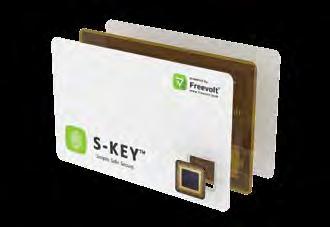
Freevolt’s pioneering product, the S-Key, stands as the world’s inaugural batteryfree biometric access control card, seamlessly linking an individual’s fingerprint to entry points. This innovation effectively mitigates the risks associated
al’s fingerprint, it eradicates the looming threat of lost or stolen cards, all without incurring additional infrastructure costs.
The S-Key effectively eliminates the risk of unauthorized access. Biometric data never leaves the card, ensuring better privacy and GDPR compliance. It seam-
lessly integrates with all existing NFC readers and is quick to adopt, with no additional infrastructure costs. Featuring hygienic, contactless technology, it is offered in both NXP MIFARE and LEGIC variants. Furthermore, it stands out as a batteryless sustainable solution, distinct from other cards, as it operates without the need for a battery.
Moreover, the S-Key offers two/ three-factor authentication and enhances security by using existing access control systems. It offers a seamless integration with them that bolsters defense mechanisms. Unlike conventional methods that rely solely on possession for access, the S-Key card mandates biometric verification, thereby nullifying the risk of unauthorized entry until a lost or stolen card is disabled.
Another key advantage of the S-Key card lies in its ability to store all biometric data directly on the card itself, eliminating the need for external data storage. This not only simplifies GDPR and privacy compliance but also ensures utmost privacy for users.
Furthermore, the S-Key card stands out as a sustainable solution, operating without the need for batteries. This not only reduces maintenance costs but also


aligns with sustainability goals, making it a viable choice for environmentally conscious organizations.
Finally, the S-Key card’s hygienic, contactless technology offers added reassurance, catering to the demands of a postpandemic world.
With its array of benefits, including seamless NFC integration, improved security measures, and effortless scalability, the S-Key card paves the way for a more secure and hygienic future in access control.
Accessing secured areas with the S-Key card follows a straightforward process. First, users hold their finger on the card’s fingerprint sensor, allowing approximately one second for authentication. Next, the S-Key card is tapped onto the 13.56 MHz reader. Finally, access is granted as the reader communicates with the card, permitting entry based on the user’s privileges. This intuitive process ensures seamless access control, simplifying operations for users.
Traditionally, biometric solutions have grappled with data protection challenges, particularly concerning regulations like
the UK and European GDPR. However, SKey circumvents this issue with its on-device approach. Biometric data is enrolled, securely stored, matched, and authenticated directly on the card itself, eliminating the need for cloud-based databases. This method not only enables seamless integration with existing infrastructure but also eliminates the necessity for costly retrofits or software updates to handle biometric data. It underscores a commitment to privacy, emphasizing individuals’ complete control over their data.
Freevolt’s S-Key targets sectors such as defense, manufacturing, chemical and food industries, and healthcare, where an additional layer of security is essential. Additionally, there’s a growing demand for S-Key in time and attendance systems across various industries. Upon arriving at work, the employees can now use their cards to enter the building, log onto computers, and release a secure printing job, with all operations being seamlessly integrated into a unified solution. This integrated approach constitutes a key value proposition, poised for widespread adoption.
At the core of Freevolt’s ethos lies a commitment to furnishing cutting-edge biometric smart cards equipped with robust
fraud protection and heightened access security. Crucially, these advancements are achieved without necessitating alterations to existing card reader infrastructure or impacting user experience.
Emerging from research conducted at Imperial College London, Freevolt represents the culmination of over seven years of development. Their suite of proprietary, patented, and patent-pending technologies harnesses and repurposes RF energy derived from radio transmission networks (including NFC, cellular, and Wi-Fi) to power innovative biometric smart cards.
Its partnership with Techman Solutions marks a significant milestone in expanding Freevolt’s global footprint. At the moment, Techman Solutions is pivotal in bringing the acclaimed S-Key cards to a broader audience in Qatar. The S-Key card, known for its cutting-edge security features and ease of use, is designed to provide enhanced digital protection for individuals and businesses alike.
The S-Key card incorporates state-of-theart technology to ensure secure access to various digital services. Its advanced encryption and user-friendly design are ideal for those seeking reliable and robust digital security solutions.
Techman Solutions, with its reputation for delivering high-quality technology products and services, is well-positioned to distribute the S-Key cards throughout Qatar.
The company’s extensive network and expertise in the tech sector will ensure that the S-Key cards are readily available to individual and corporate clients.
The S-Key cards are available for order through Techman Solutions. Customers can now benefit from the convenience of securing these cards directly from a trusted local distributor. This partnership is expected to positively impact the digital security landscape in Qatar. Techman Solutions’ commitment to providing top-tier technology solutions and Freevolts’s reputation for innovative security products set the stage for a successful collaboration that will benefit customers across the region. n
Cities of the Middle East region are also actively adopting AI technologies to keep up with the expanding number of urban threats
n By: Mirza Bahic mirza.bahic@asmideast.comEveryone wishes to live in a safer city, a place that gives its residents and visitors a secure vibe to live, work, and travel without any security fears. The changing world does not allow the CCTV business to stand still. To survive, it must constantly evolve, and new technologies come to the rescue against new threats.
TRASSIR understands that it is not enough just to equip the buildings and the outer premises with cameras to call the city a safe place. In addition to the cameras, an intelligent security system is usually required that can correctly interpret and analyze surveillance images and videos and inform people in charge, so that the right actions could be taken in a timely manner. TRASSIR is an AI Video surveillance and security systems and software developer since 2002 that invests a lot of resources in AI technology development at the moment. AI is transforming value to all city agencies from public health, urban planning, and transportation to public services and safety. Let’s take a closer look at the various city sectors and use real examples that show how TRASSIR

AI is transforming value to all city agencies from public health, urban planning, and transportation to public services and safety
AI-based analytics can help solve a variety of metropolitan challenges and transform urban safety.
Surveillance cameras installed in public places can protect from a lot of urban threats, such as burglaries, pick-pocketing, sexual assault, vandalism, or child trafficking - these are just some, and there are so many others. Furthermore,
in the event of a public health emergency, such as the COVID-19 pandemic, data can be gathered via AI-powered video surveillance on whether people are wearing face masks (TRASSIR Face Mask Detector) or following social distancing rules (TRASSIR Crowd Detector).
Educational institutions are usually areas of increased visitor activity, and a good ex-

ample is the Islamic University of Madinah, which was established by the government of Saudi Arabia by royal decree in 1961 in the Islamic holy city of Medina. TRASSIR was able to upgrade and replace the security system there and improve overall security by installing TRASSIR Neuro Counters and Workplace Detectors. The TRASSIR CCTV system is now being used to monitor the activities of students, staff, and visitors, and helps to ensure security and discipline. TRASSIR modules can also significantly reduce the burden on security services, giving them more time to respond to serious incidents during major festivals and celebrations, which typically gather large numbers of people. The Saudi Feast Festival, the largest of its kind in the Middle East, which was held from December 12, 2022, to December 29, 2022, hosted visitors in a unique experience to consolidate and preserve Saudi cuisine. Thanks to the TRASSIR Neuro Counter functionality, the event coordinators were able to obtain attendance statistics, in particular the total number of visitors, create a portrait of the visitors, and divide them by age and gender for event statistics.
Religious public institutions in large cities also require a high level of security for all visitors and staff, as well as protection
Religious public institutions in large cities require a high level of security for all visitors and staff, as well as protection against terrorism, vandalism, and anti-social behavior
against terrorism, vandalism, and anti-social behavior. Kuwait has very high security requirements, so the choice of TRASSIR CCTV systems for the Bin Nabhan Mosque is certainly a victory for the company in the global market. It is a well-preserved architectural monument, a center of tourism and pilgrimage for believers. By installing TRASSIR Neuro Detector, cameras, Mini NVR, and TRASSIR NeuroStation there, full monitoring of the area and perimeter of the mosque, including parking lots, was provided. Outdoor cameras detect gatherings of guests near the walls and adjacent streets, and there is special monitoring of restricted areas and holy sites. The health, life, and peace of mind of clerics and visitors, the property of the mosque, and worshippers are protected.
Fast food restaurants also play a role in portraying an urban lifestyle. TRASSIR has developed from scratch a work plan and technological solutions for the young and ambitious BBT company in the State of Kuwait. The Neurostation Compact RE system was implemented together with four modern TR-D2253WDZIR7 video surveillance cameras at their brand-new, stylish HILL-
TOP restaurant. Thanks to the introduced solution, BBT company has reduced the waiting time for the customers’ orders by 30%. The core feature of Best Burger in Town - fast on-the-go service - has remained preserved, and as a result, there are no long queues during rush hours. These are just some examples of TRASSIR’s accomplished history of providing safety solutions for different businesses such as public institutions, festivals, educational centers, and public restaurants, and TRASSIR is proud to be a part of every project that helps to promote safety and security. Ethical considerations regarding AI and privacy are at the forefront of future developments. The integration of surveillance technologies in smart cities inevitably raises privacy and data protection concerns. Striking a balance between using these technologies for public safety and respecting individual privacy rights is a critical challenge. Going forward, TRASSIR aims to use the knowledge gained from completed projects to improve efficiency, sustainability, and safety for greater security in the MEA region, making a hassle-free journey to a safer urban environment within reach. n
Suprema’s innovative AI-based security solutions are reshaping physical security in the Middle East, meeting the evolving needs of the region’s infrastructure development and ensuring safety for residents and visitors alike
n By: Mirza Bahić mirza.bahic@asmideast.comThe Middle East market is currently a focal point on the global stage, particularly with the trend toward integrating cutting-edge technologies within physical security systems. This includes adopting AI, machine learning, and IoT devices in security systems. Concurrently, the region is undergoing significant infrastructure development, heavily investing in modernizing urban environments with projects like Neom City in Saudi Arabia and Pearl Qatar. These projects necessitate advanced physical security systems to protect assets and ensure safety for residents and visitors.
Suprema, a global leader in AI-based security solutions, has established a strong presence in the Middle East based on a robust brand reputation and extensive partner network. Suprema’s technical superiority and reliability are proven by serving various customers including banks, government agencies, hospitals, residential complexes, and schools in the Middle East. Suprema offers innovative access control and video management

Suprema offers innovative access control and video management platforms integrated with AI, cloud, and UWB-based technologies
platforms integrated with AI, cloud, and UWB-based technologies. Suprema supports the industry’s most extensive range of multi-credential options including facial authentication, fingerprint recognition,
RFID, PIN, mobile access, QR, and barcode. By offering a vast product portfolio and the capability to meet the needs of various customers, Suprema has become a reliable and industry-leading se-
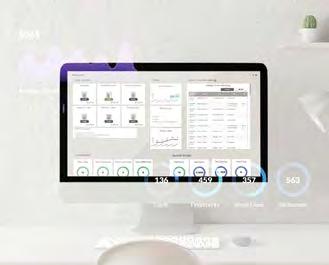
curity service provider in the Middle East market, ensuring safety and efficiency.
Suprema’s integrated security platform, BioStar 2, features a scalable and flexible architecture designed to meet the diverse security requirements of businesses of all types and sizes. The platform’s Multi-Communication Server (MCS) supports a multi-server architecture, supporting extensive device installations and a large number of user enrolments. Also, the flexible architecture of BioStar 2 supports security management ranging from small and medium-sized businesses to large-scale organizations. Additionally, BioStar 2 is integrated with a video management system (VMS) and on-device AI access control solution, so it provides AIbased security management by applying Suprema’s proprietary AI algorithms to access control and video management. This enables comprehensive management of real-time video monitoring and access data on a single interface.
Suprema has made a significant advancement by incorporating AI into its biometric access control technology, becoming the first company worldwide to integrate NPU-based deep learning AI into biometric authentication. Suprema BioStation 3 and BioStation 2a, are AI-based facial authentication and fingerprint recognition access control solutions. They deliver the world’s highest performance in AI-based biometric recognition in terms of accuracy and speed.
Suprema ‘CLUe’ is a cloud-based access authentication service that integrates Suprema devices with thirdparty cloud platforms without requiring server adoption. Known for its simplicity in management and installation, the CLUe service is widely used in various verticals for membership and visitor management. In particular, unmanned stores are increasingly adopting this service as it enhances operational efficiency and security.
Suprema is revolutionizing physical security with UWB technology. It enables seamless walk-through access authentication entry for authorized individuals without any physical interaction just by holding a smartphone access is granted based on proximity and intent. UWB technology allows for extremely accurate and fast location tracking within a 5-10 cm range of error, which outperforms the capabilities of Wi-Fi or Bluetooth.
“Our commitment to the Middle East market remains strong, especially since market research reports have recognized Suprema as holding the number one market share in biometric access control in the EMEA region,” said Suprema Inc. CEO Hanchul Kim. “Suprema will support this dynamic market and expand further with AI-based security solutions, aiming to enhance the security of an even broader range of customers in the Middle East.” n

Tracking employee hours without error is one of the most significant responsibilities of human resources departments in any size organization. The need for an accurate, fast, flexible, and easy-to-use solution drives innovation in the process IRIS ID

PINs, these unique data points cannot be shared, eliminating the costly payroll fraud known as buddy punching.
Among available biometric time and attendance choices, a rapidly growing number of companies are taking advantage of iris recognition’s unique capabilities to integrate highly accurate, environmentally tolerant, and hands-free time and attendance solutions that simplify and streamline business operations. Recent advancements in capture technology, matching algorithms, and usability, along with reductions in product and de-
It is this unparalleled performance in harsh and unpredictable locations where other biometrics often fail that makes iris-based platforms a practical solution in today’s challenging workplace environments
ployment costs, have made iris-based time and attendance a practical investment for companies of every size. Most organizations implementing iris-based time and attendance achieve significant, quantifiable, cost-justifying benefits within the first few months of operations.
Iris recognition offers contactless features that are uniquely suited to the demands of time and attendance applications to deliver
high, user-friendly performance in biometrically unfriendly workplaces such as manufacturing floors, construction sites, and processing plants. It is this unparalleled performance in harsh and unpredictable locations where other biometrics often fail that makes iris-based platforms a practical solution in today’s challenging workplace environments. First of all, iris recognition is a fast and stable process. A person’s unique iris

IrisTimeTM software automatically calculates employee hours, speeding up the payroll process and removing the element of human error and HR staff time to enter data
pattern is formed by 10 months of age and remains stable throughout life. Full system enrollment with instruction can take less than a minute while authentication takes less than 2 seconds.
Next, iris-based systems are more accurate and reliable than other security alternatives - biometric or otherwise. A distinctive iris pattern is not susceptible to theft, loss, or compromise. Also, the authentication is non-invasive and requires no physical contact for confirmed identification. The imaging process includes no bright lights or lasers - enrollment and identity authentication is the same as taking a picture with a digital camera. Finally, this method is expandable, scalable, and flexible. Iris data templates require only 512 bytes of storage per iris and even extensive databases do not compromise search speed or degrade performance accuracy. The technology operates in a stand-alone mode and easily integrates with existing time and attendance systems. Iris platforms are highly scalable, meeting the needs of small- to medium-sized businesses and enterprise organizations.
The contactless IrisTime platform combines features and performance not found in any other iris-based biometric device for time and attendance. It has the highest degree of accuracy expected from a biometric device. It’s easy to use with on-device employee enrollment which can save time and eliminate the need to maintain a separate station for new hires. Once enrolled, employees may clock in with other networked readers in the same building or
virtually anywhere in the world.
IrisTimeTM offers a comprehensive turnkey solution, featuring embedded software that is instantly prepared to handle various tasks such as importing, exporting, and managing user data, as well as retrieving and monitoring transactions. Additionally, it can seamlessly detect new devices and perform necessary updates or removals of readers automatically. With the ability to manage administrator accounts, IrisTime operates smoothly across Windows, Linux, and Mac platforms, facilitating accessibility from tablets and smartphones.
The IrisTime software automatically calculates employee hours, speeding up the payroll process and removing the element of human error and HR staff time to enter data. Employees may receive text messages alerting them to the need to take regulatoryrequired breaks. And the system can quickly expand as a business adds new locations. The platform further enhances accuracy with a fusion of iris and facial recognition to provide a choice of identifiers or a higher accuracy in authenticating employees. Liveness detection is built into each reader to virtually eliminate spoofing the system with photographs, prosthetics, and amputated or injured eyes. Innovative, cost-efficient, and flexible IrisTime biometric time clocks from Iris ID have arrived to meet the needs of a modern workforce.
Two customer success stories showcase Iris ID’s technology effectively meeting time and attendance needs in challenging operational environments. Turkey’s Anadolu Etap, a major fruit and vegetable juice provider to Europe, encountered complex payroll challenges due to fluctuating schedules and seasonal labor. Traditional timecards were impractical, and smart cards posed logistical and security issues. Implementing outdoor iris readers provided accurate tracking, even for transient workers, streamlining payroll management for over 10,000 employees.
Similarly, Nigeria-based Dangote Industries, a leading conglomerate in sub-Saharan Africa, sought a contactless biometric solution for its diverse operations. Despite challenges with facial recognition systems, Iris ID’s iris-based solution proved accurate and efficient, seamlessly integrating with their enterprise systems and facilitating asset tracking at cement plants.
Since its formation in 1997, Iris ID has developed identity authentication systems that are used more frequently than all other iris recognition alternatives combined. The company is committed to the ongoing development of iris recognition platforms that incorporate robust security features and offer improved speed, enhanced usability, and lower equipment and ownership costs. Iris ID’s time and attendance applications are no exception. Iris ID’s solutions achieve unparalleled performance in harsh and unpredictable environments and more conventional workplace settings. Iris ID is uniquely positioned to provide these solutions as organizations look to leverage existing facilities and capabilities more effectively to simplify and streamline their business operations. The company’s products are used in thousands of locations daily authenticating millions of people’s identities on six continents. Iris ID was named to the 2020 Inc.5000, a list of America’s fastestgrowing private companies. n
The convergence of cyber and physical security systems emerges as a vital strategy to address multifaceted challenges effectively
n By: Mirza Bahić mirza.bahic@asmideast.comIn today’s world, where data breaches and security threats are rampant, organizations face significant risks to their physical assets, financial stability, and reputation. The potential damages from such incidents can be severe, ranging from operational disruptions to irreparable harm. As a result, maintaining a robust security posture has become imperative for organizations of all sizes.
Security convergence integrates cybersecurity and information technology strategies with physical security measures. This approach aims to enhance awareness and bolster the protection of facilities, individuals, and data comprehensively.
In essence, converged security combines the efforts of safeguarding physical assets, such as through access restriction, video surveillance deployment, and intrusion detection, with the protection of digital assets like computers, networks, and applications. This provides the organization with a consistently comprehensive overview of its security posture.
“As the digital landscape continues to evolve, the integration of cybersecurity and physical security measures is no lon-
ger just an option, it is a necessity. The more systems we converge, the stronger our security becomes.” Mr. Shaji Abdulkadar, Chief Operating Officer, ScreenCheck.
Consolidating an organization’s IP networking onto a single infrastructure brings forth a myriad of benefits, ranging from enhanced security to improved operational efficiency. By applying consistent policies across all data systems, organizations can ensure standardized levels of security, reliability, and manageability, mitigating the risk of costly breaches and downtime.
Integrating physical and cybersecurity systems allows for more comprehensive threat detection and faster response times. By sharing information and collaborating, security teams can identify and mitigate threats swiftly and effectively.
Regulation compliance is facilitated by integrated systems, which enable thorough
security audits and reporting. Real-time data from both physical and cyber security systems provides a more comprehensive picture of the security landscape, allowing for better decision-making.
Integrating systems can eliminate the need for redundant infrastructure and software, leading to cost savings in the long run. It reduces the need for separate systems and licenses.
ScreenCheck collaborates with industry leaders like STid, IDtech, Suprema, Moca System, DaoSafe, and many others, revolutionizing security solutions. By integrating advanced technologies, ScreenCheck offers comprehensive security solutions that bridge the gap between physical and cybersecurity.
IDtech’s advanced access control systems, encryption protocols, and intrusion detection systems fortify organizations’ defense mechanisms. Through multifactor authentication (MFA), AES-128 encryption, and continuous monitoring, organizations achieve a layered defense against unauthorized access and data compromise. ScreenCheck brings IDtech’s solutions to the market, ensuring

comprehensive protection for sensitive data and assets.
Suprema’s advanced biometric solutions leverage AI and deep learning technologies to offer enhanced security. With features like encryption protocols, communication protection, and security tamper support, Suprema ensures compliance with international standards while safeguarding personal data. ScreenCheck integrates Suprema’s solutions to address
specific security threats and overcome privacy concerns effectively.
Moca Systems provides 100% cloudbased access control solutions, facilitating converged security management. Leveraging cloud-based solutions, organizations gain flexibility in managing both cyber and physical systems, enabling remote management and monitoring from any location. ScreenCheck’s collaboration with Moca Systems streamlines conver-
gence, offering a unified platform for efficient access control and incident management.
DaoSafe’s pedestrian access management systems integrate seamlessly with various security systems, including access control and alarm systems. This integration forms a uniform management platform, enabling timely responses to incidents and enhancing security levels in schools and organizations. ScreenCheck’s partnership with DaoSafe ensures robust access control and incident management, fostering a safe and convenient environment.
As the number of connected IoT devices is projected to reach 27 billion globally by 2025, emerging technologies like artificial intelligence and the Internet of Things (IoT) are expected to shape the future of integrated security. However, organizations must navigate challenges such as adapting to evolving threats and balancing security with privacy concerns as they embrace these advancements.
In today’s threat landscape, relying solely on either physical or cybersecurity measures is no longer sufficient. By integrating these two realms of security into a cohesive defense strategy, organizations can build a strong defense that effectively mitigates risks and safeguards their assets. Adopting this holistic approach is crucial to remaining ahead of the curve and safeguarding against the constantly changing challenges that confront companies and organizations nowadays. ScreenCheck’s goal is to make these transformative technologies easily accessible and implementable for organizations of all sizes. Through our innovative solutions and strategic partnerships, ScreenCheck empowers businesses to seamlessly integrate the latest security trends into their strategies. n
ASSA ABLOY
The ProSecure 4 door sets a new benchmark in security with certified resistance to prolonged and complex attacks, including those involving power tools
n By: Mirza Bahić mirza.bahic@asmideast.comIn a world where the threat landscape is constantly evolving, safeguarding assets and sensitive information is paramount. The ProSecure 4, a high-security door engineered to withstand sophisticated breach attempts, offers unparalleled defence against external threats. Designed with robust materials and advanced security features, it stands as a formidable barrier against determined intruders.
The ProSecure 4 high-security door significantly advances beyond the ProSecure 2 & 3 models by offering at least 10 minutes of resistance against category D tools—powerful instruments used in serious breaches. This enhancement is tested under conditions lasting 30 minutes, demonstrating the door’s ability to withstand prolonged attacks and delay intrusions effectively.
This significant improvement in resistance time places the ProSecure 4 door at the apex of the D10(SR4) classification according to LPS 1175 issue 8, a high security rating under the current standards. Designed to thwart the efforts of the most determined attackers, the ProSecure 4 door is crucial for a broad array of commercial

environments. Beyond financial institutions, data centers, and government facilities, this superior level of protection is paramount for airports, shopping centers, embassies, stadiums, to name a few.
The ProSecure 4 sets a new benchmark for technical excellence in high-security doors, merging advanced hardware with superior design. It integrates the state-ofthe-art Abloy or Mottura MultiPoint Mortise Locking system, in mechanical, electrified and motorized forms, showcasing exceptional craftsmanship and locking precision. High-security cylinders from le-
aders like Abloy and Mul-T-Lock, designed to thwart drilling and picking, significantly add to its security profile.
ProSecure 4 from ASSA ABLOY features a unique architectural aesthetic by using mortise locks instead of surface-mounted locksets, setting it apart as the only one of its kind in the Middle East.
Constructed with a mix of durable steel types, the ProSecure 4 combines physical attack resistance with fire rating and longevity. Its adaptable design accommodates single or double leaf configurations, meeting diverse architectural demands. Aesthetically, it features any standard RAL finish with options for stainless steel, bronze, or copper cladding, allowing for architectural integration and enhance-

ment. Further bolstering its utility, the door is equipped with a suite of accessories such as door closers, BMS-compatible access control systems, and automatic operators. These features ensure robust security and seamless operational efficiency, underscoring the ProSecure 4’s position as a comprehensive solution for advanced security needs.
The ProSecure 4 doors are produced in ASSA ABLOY Opening Solutions Middle East’s state-of-the-art Dubai One facility, ensuring swift delivery and reduced lead times through local manufacturing. This approach allows to rapidly meet the security needs of our main markets in the Middle East and Africa, with the added flexibility to serve neighboring regions

ProSecure
4 door is crucial for a broad array of commercial environments. Beyond financial institutions, data centers, and government facilities, this superior level of protection is paramount for airports, shopping centers, embassies, stadiums, to name a few.
as well. The factory serves as more than just a production facility; it’s a comprehensive support hub. Here, the local team offers everything from technical assistance to guidance on product selection and installation, providing endto-end support to ensure each security solution is implemented with precision and care.
The Certified Assurance of ProSecure 4 Doors
The ProSecure 4 doors have the mark of effective security from BRE certification and are tested according to LPS 1175:ISSUE 8, with security rating D10 (SR4). These prestigious certifications assure our clients that they are investing in the highest standard of security, tested by global leaders in safety and security. In conclusion, the introduction of the ProSecure 4 high-security door marks a significant leap in security innovation, offering unmatched protection and peace of mind. In an era where threats are everpresent and evolving, investing in ProSecure 4 means choosing a future where assets and information remain safeguarded by the best in the industry. As the landscape of threats evolves, so does ASSA ABLOY’s commitment to securing the future with state-of-the-art solutions like the ProSecure 4. n

Saif bin Zayed Al Nahyan’s patronage heralds the International Exhibition for National Security & Resilience, showcasing the latest solutions at ADNEC Centre, Abu Dhabi in May
n By: Mirza Bahić mirza.bahic@asmideast.comUnder the patronage of H.H. Lt. General Sheikh Saif bin Zayed Al Nahyan, Deputy Prime Minister and Minister of the Interior, the International Exhibition for National Security & Resilience (ISNR) is returning for its eighth and largest edition on May 21 to May 23 at the ADNEC Centre Abu Dhabi. This leading exhibition is organized by ADNEC Group in cooperation with the Ministry of Interior and in
strategic partnership with Abu Dhabi Police General Command (GHQ), showcasing security innovations and solutions that enhance national security, cybersecurity, police and law enforcement, and the protection of vital facilities.
With its esteemed heritage, this biannual event stands as a platform uniting national and cybersecurity officials, buyers, and stakeholders from both the public and private sectors. It serves as
a crucial forum for conducting business, fostering industry leadership, and spotlighting innovation to shape and influence future projects.
Major General Dr. Ahmed Nasser Al-Raisi, Chairman of the Supreme Organizing Committee of the Exhibition, said: “We gather at the eighth edition of ISNR 2024 to emphasize the pivotal role of the exhibition in advancing the fields of national security protection, addressing challenges in cybersecurity and artificial intelligence, which are essential for safeguarding the nation’s security and its assets.”
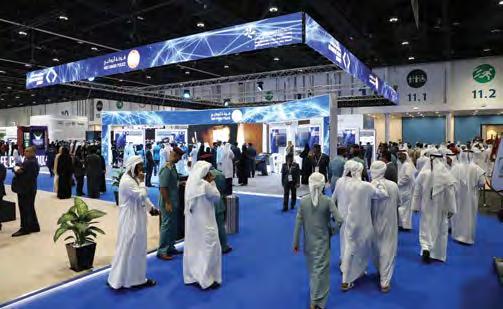
Al-Raisi added, “ISNR 2024 is a fundamental platform for enhancing mechanisms of innovation and dialogue, shaping the future of national security, and working to mitigate risks. The exhibition will contribute to building collaborative relationships for investing in innovation, enhancing the efforts of relevant entities, cybersecurity officials, buyers, and stakeholders in the supply chain to strengthen national security and adhere to the best global practices to ensure a safer and more stable future.”
Humaid Matar Al Dhaheri, the Managing Director and CEO of ADNEC Group, said: “This edition of ISNR is expected to
witness record participation from leading specialized companies, in addition to a wide range of experts and specialists from around the world, making it the largest in the exhibition’s history since its inception.”
Al Dhaheri explained that this exhibition is a testament to our commitment to implementing the wise leadership’s vision, represented in adopting the latest technologies to enhance sustainable national security. ISNR Abu Dhabi 2024 plays a pivotal role in promoting innovation, collaboration, and readiness to address numerous security challenges and deal with

them to achieve comprehensive security locally, regionally, and globally.
ISNR 2024 will feature leading specialist speakers from across the globe to uncover the latest trends and developments in the vital fields that enhance national security through technological solutions. Additionally, the exhibition offers a unique networking platform connecting regional government bodies with security solution providers from across the globe. The event offers an opportunity for technology and security experts to discuss and uncover solutions to new challenges in several fields, promoting best practices to avert the ever-growing threats they are facing. The eighth edition of the exhibition will see the ISNR Innovation Awards returning. This unique and competitive feature is open to all ISNR Abu Dhabi exhibitors willing to use the event as a platform to officially release their disruptive innovation to the security market. The Innovation Awards offers exclusive multi-channel campaign exposure, before, during, and after the event as a unique chance to stand out from the competition and raise the attention of stakeholders. n
Secutech 2024 once again distinguished itself as a global hub of innovation, showcasing cutting-edge security trends, fostering industry collaboration, and highlighting the integration of AIoT technologies to elevate security standards
n By: Mirza Bahić editorial@asmideast.comSecutech 2024 marked a triumphant return, drawing large crowds and much enthusiasm with its showcase of cutting-edge security trends and technologies. Held from April 24th to 26th, 2024, at Hall 1 of the Taipei Nangang Exhibition Center, the event boasted a record 15,120 square meters of exhibition space and hosted 300 renowned exhibitors from across the globe. With a focus on smart security solutions and technologies, Secutech 2024 encompassed various security applications spanning security, fire prevention, disaster prevention, smart building, and transportation. Concurrently, other significant events took place, including Fire&Safety 2024, Mobility 2024, SmartRail 2024, and SMABuilding 2024.
Drawing in a diverse audience, the threeday event attracted a total of 15,123 visitors, including 14,438 domestic attendees and 685 international guests from 61 countries. Major overseas participants hailed from Japan, Singapore, China, Thailand, Indonesia, and the USA, reflecting Secutech’s international allure and impact. Complementing the massive exhibition floor were 19 seminars comprising 124 sessions, captivating 2,140 participants with insightful discussions and thoughtprovoking insights. Additionally, Secutech 2024 played host to 69 delegates from seven regions and countries, facilitating 93 buyer-guided tours that provided inval-

uable opportunities for engagement and exploration.
Diving deeper into the event’s offerings, attendees had the chance to explore eight Solution Zones, including the Security+AIoT Zone, AI Clubhouse, TTEIA Pavilion, Smart Factory & Industrial Safety Pavilion, Warehouse Fire Safety Pavilion, Smart Building and Living Application Pavilion, Fire Protection/Disaster Prevention & Rescue Technology Pavilion, and the Smart Rail Zone.
Furthermore, six special pavilions, such as the 5G Pavilion, Low-Carbon Net-Zero Building Pavilion, Building ESG Solutions Pavilion, Disaster Prevention Industry Pavilion, Metro Taipei Pavilion, and TSLIA Pavilion, added to the event’s immersive experience and showcased the latest innovations and advancements in their respective fields.
Secutech 2024 also featured a lineup of comprehensive seminars, covering top-
ics ranging from smart security and rail systems to logistics, industrial safety, and disaster prevention. With each session attracting diverse attendees, the event fostered knowledge exchange and facilitated dialogue among industry experts and enthusiasts alike.
This year’s event, themed “Intelligent Security Automation and Smart Operation Management,” focused on leveraging AIoT (AI and IoT) to enhance security and operational efficiency. Exhibitors like VIVOTEK showcased solutions such as Case Vault, utilizing AI cameras to simplify search and forensic operations by identifying people and vehicles, even distinguishing unique features like clothing colors. Merit LILIN demonstrated AIoT technologies in a smart carwash use case, granting entry

based on ALPR camera plate matching. They also showcased advanced camera models, enhancing surveillance capabilities. With data privacy in focus, RogersAI presented a solution using time-of-flight technology to protect facial depth data, ensuring privacy in scenarios like banks and offices.
At the forefront of AI innovation, exhibitors like Foresight were showcasing AI solutions tailored to diverse applications. Their factory solution, capable of distinguishing good seeds from bad, aids food factories in achieving better yields. Additionally, their office AI application streamlines operations by providing instant responses to queries about company rules and guidelines, akin to ChatGPT.
Vacron’s smart transportation applications, powered by their mobile DVR, detect driver fatigue and hazardous road conditions, enhancing passenger safety. Their Daycare Surveillance Cloud System ensures child safety by preventing video loss and promptly alerting staff to potential accidents. Hunt’s AIoT-enabled solutions, including illegal garbage disposal detection and cutting-edge thermal cameras, address various societal challenges. Exhibitors like COP Security Systems also spotlighted top-quality made-in-Taiwan hardware, such as Ethernet-over-coaxial transceivers for integrating IP cameras with existing coaxial infrastructure, PoE extenders for extending coverage distance, and IR illuminators for enhanced visibility in wide areas.
Smart rail, an important point at this year’s exhibition, addresses the pressing need for enhanced rail track monitoring amidst labor shortages. 3S demonstrated a comprehensive solution integrating advanced hardware and software capa-
chip (SoC), are fundamental to security camera functionality, so Augentix showcased its cutting-edge multimedia signal processing and high-definition turnkey solutions. From entry-level to advanced camera solutions, Augentix showed a range of products for diverse applications including drones, dashcams, and sports cameras.
Accord, a leading manufacturer of keypads, presented their integrative capabilities at Secutech, with offerings ranging from standard and waterproof keypads to military-grade and silicon rubber keypads. With over three decades of expertise, Accord has delivered customized solutions with rapid turnaround times and competitive pricing.
Recognizing the pivotal role of installers and systems integrators (SIs) in the security industry, T3 Innovation presented

ble of detecting objects, intrusions, and irregular events along the tracks. Their innovative system not only identifies foreign objects but also determines their size, providing operators with invaluable insights and situational awareness.
Key components, such as systems-on-

a suite of tools designed to streamline installation processes. Their professional heavy-duty crimper for RJ45 modular plugs features a zinc body, carbon steel handle, and built-in cable cutter and stripper, ensuring stable and precise crimping for enhanced efficiency. Additional products on display included snap plugs and stranded patch cords, catering to the diverse needs of installers and SIs.
Looking ahead, the anticipation for the next edition of Secutech is already building. The event is scheduled for May 7th to 9th, 2025, at the 1F, Hall 1 of the Taipei Nangang Exhibition Center, promising yet another immersive and enlightening experience for all participants. n
SECON & eGISEC 2024 showcased the latest advancements in AI integration within the security industry, with exhibitors presenting innovative solutions ranging from centralized control platforms to fire-detection systems, highlighting AI’s pivotal role in shaping the future of security
n By: Mirza Bahić editorial@asmideast.comAsia’s only integrated security exhibition, SECON & eGISEC 2024, has successfully ended. These are the only regional events that cover both physical security and cyber security sectors, including video surveillance, cyber security, access control, social security systems, homeland and industrial security, and IoT security. This year, the main theme of SECON & eGISEC 2024 was treated under the motto of “World becomes safer with AI”. A total of 396 exhibitors from 13 countries presented their products and solutions to over 25,000 visitors from more than 30 countries. The pre-registration rate increased by 14% compared to last year, indicating heightened anticipation among visitors for the exhibition.
Given the current global spotlight on AI, SECON & eGISEC 2024 featured numerous companies that effectively integrated AI into physical security. As a representative example, IDIS showcased iNex, an all-in-one security platform that enables centralized control, including AI video monitoring represented by CCTV, core disaster response systems such as e-disaster systems, AI parking guidance control systems,

Suprema showcased an AI-integrated recognition security solution applying their self-developed AI algorithms to access control and video security
etc. Suprema showcased an AI-integrated recognition security solution applying their self-developed AI algorithms to access control and video security. This innovation attracted significant interest not only from PropTech companies requiring access authentication services but also from cloudbased attendance management and security control service providers.
INCON, underlining its slogan “Building A Safe Society With INCON’s Active AI Solution,” presented Active AI VMS, a nextgeneration convergence intelligent event management system that enables active decision-making. This system offers convergence-based civil safety services, enabling event analysis through interworking with heterogeneous equipment and

solutions, risk prediction via advanced AI platform structures, and prompt situational judgments.
DEEPNOID, committed to establishing an AI ecosystem, provides a range of AIbased security solutions, including information security, decoding copy-read, and decoding harness systems. At SECON & eGISEC, they introduced DEEP SECURITY, an AI solution designed to automatically scan information security items upon entry to a company, attracting the attention of officials from public institutions and large corporations.
WatchCam, a company specializing in unmanned surveillance equipment, unveiled the Wava-One AI Video Analyzer V2.0, designed for fire-detecting in fireprone locations. This innovative product undergoes primary verification through a camera internal detection sensor with improved non-fire warning, AI video analysis, and secondary verification through an AI video analysis program within the video verification device.
SECON & eGISEC Digital Showroom was the place where the visitors could learn more about the exhibitors and their products and solutions, with an addition that it would be still available after the exhibition.
More than a hundred buyers and delegates from nine countries, including Hong Kong, Thailand, Vietnam, Singapore, Malaysia, New Zealand, Albania,
Bahrain, and India, were officially selected and invited to SECON & eGISEC 2024. The event manager organized a business matching program between hosted buyers and delegates, exhibitors, and visitors to facilitate product purchases and share related insights. Business meetings were actively conducted to prop up a strong global network. This culminated in over 460 meetings with more than 170 exhibitors in total, representing a nearly 35% increase compared to last year.
Globally influential security media were meticulously chosen for the SECON and eGISEC 2024 Press Invitation Program, guaranteeing extensive promotion of SECON & eGISEC worldwide and targeting key stakeholders in the security industry on a global level. A number of overseas media companies from 6 countries were invited based on their influence on the security industry, including China, Middle East Asia, Singapore, Taiwan, Australia, Japan, etc.
During the event, a variety of informative conferences and seminars were held, consisting of 25 tracks and over 100 sessions. Particularly noteworthy
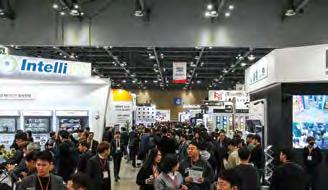
for overseas visitors was Security World Conference 2024, where senior analysts specializing in physical security and cyber security markets from OMDIA, a global market research organization, shared global security trends and market forecasts for the year. Cyber Security Experience Zone was a notable highlight event in the exhibition, offering attendees an interactive experience with major cyber security threats and countermeasures, such as smartphone hacking, dark web exploration, passwordless authentication, and quantum cryptography.
As an eco-friendly exhibition, SECON & eGISEC 2024 required all members of the event to practice environmental conservation. It pursued policies to reduce carbon emissions by reducing waste generated between device construction and demolition, using recyclable materials for booths, and using recyclable containers for food and beverage. For example, the organizer prohibited double-deck booths, drastically lowered the height of exhibition booths, and encouraged the use of recyclable materials for booth designs. As a result, the ratio of the disposable booths among the entire raw space booths decreased by about 10% compared to last year. Moreover, there has been a reduction of over 5% in the waste produced from booth construction, demolition, and signage compared to last year.
SECON & eGISEC 2025 will be held at KINTEX, Korea on 19-21, March 2025. At SECON 2024, over 80% of the total net space was rebooked onsite for SECON & eGISEC 2025. It is anticipated that next year’s event will feature 28,000+ m² gross space, 400+ exhibitors, 25,000+ visitors, and 200+ conferences and seminars. As new IT technologies, including AI, edge computing, quantum computing, and automation, continue to advance, security trends are adapting accordingly. Reflecting these technological shifts, exhibition categories have been reorganized starting from SECON & eGISEC 2025. It will be specified as Video Surveillance, Access Control, AI Security, Cyber Security, Industrial Security/OT Security, Social Security System, Homeland Security, and Smart City Security Solutions. n
OFSEC 2024, Oman’s premier summit and expo on fire, safety, and security, aims to unite global leaders, foster innovation, and set new standards to safeguard industries and communities in the Middle East and beyond
n By: Mirza Bahić mirza.bahic@asmideast.comThe 8th Edition of OFSEC, Oman’s only and most comprehensive summit & expo on fire, safety, and security is scheduled for 08 – 09 October 2024. OFSEC EVENT 2024 is crafted to address the requirements of the local, regional, and international markets. It serves as a vital link connecting practitioners, suppliers, distributors, and manufacturers from the fire, safety, HSE, and security industry with key decision-makers from both government and private sectors. This platform fosters networking, initiates new projects, and cultivates visionary partnerships. Furthermore, the event aims to foster synergy and bolster collaboration between authorities and industries.
The two-day Exhibition & Summit is poised to draw participants from a multitude of exhibitors and over 30 countries. It will unveil many product and service launches catering to trade visitors and potential buyers from the region and beyond. The Summit promises an extensive lineup of esteemed speakers, case studies, panel discussions, and unique presentations. Attendees can anticipate gaining access to a wealth of industry-leading knowledge, sharing best practices, spotlighting trends, exchanging insights, and leaving with actionable takeaways.

The Commercial Security section will showcase cutting-edge security solutions and systems tailored for ministries, government agencies, homes, offices, hospitality, and retail sectors
OFSEC has forged collaborations with government bodies, leading industry associations, research partners, and specialists. This strategic partnership aims to establish an exhibition that comprehensively caters to the fire, safety, and security sectors, making the event a pivotal convergence point. The expo is aligned with market demand and supply across various industries, facilitating the exchange of best practices, addressing
challenges, and exploring innovative methods for integrating safety and security technologies.
Highlighting innovations in various industry sections
Event highlights encompass a broad spectrum including Commercial Security, Emergency Rescue, Homeland Security, Smart Home/Office/City, Crisis

& Risk Management, Fire & Protection, Information Security, Training & Consultation, Unmanned Aerial Vehicle, Critical Infrastructure, Hazard & Disaster Management, Safety & Health, and Transport Safety & Security.
The Commercial Security section will showcase cutting-edge security solutions and systems tailored for ministries, government agencies, homes, offices, hospitality, and retail sectors. Emphasizing the integration of smart and innovative technologies, this section aims to ensure continued and uninterrupted operations for both public and private sectors.
The Smart section will exhibit products, equipment, and advanced systems enabling sophisticated remote access, monitoring, and control for homes, offices, and cities. From audio/video door entry systems to biometric identification and building management systems, this segment will demonstrate the latest in smart technology.
In the realm of Fire and Protection, industrialization and urbanization have presented new challenges necessitating advanced fire safety, protection, and detection technologies. The section will feature innovative solutions including break glass detection systems, heat, smoke, and fire detection systems, emergency alarm and warning systems, among others.
The event will feature a dedicated SME Pavilion, providing entrepreneurs and local start-ups with a platform to showcase their products and services alongside international participants. Additionally, the Outdoor Demonstration Area will offer a unique opportunity to
OFSEC 2024 is poised to be the premier event that demonstrates Oman’s commitment to safety and security. It will unite local and international participants showcasing state-of-the-art solutions, technologies, innovations, and costeffective products and services tailored to governments, businesses, industrial & commercial entities, and various sectors including aviation, construction, infrastructure, transportation, manufacturing, oil and gas, and utilities.
The event will not only lay the foundation for current market trends but also serve as a gateway to future innovations in the fire, safety, and security sectors. Thro-

captivate key decision-makers with live demonstrations. With its comprehensive offerings, OFSEC 2024 is set to redefine standards in the fire, safety, and security industry, fostering collaboration, innovation, and growth.
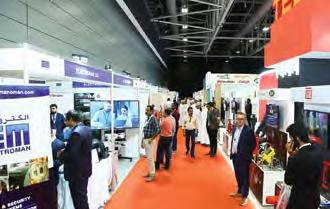
ugh communication, idea-sharing, and solution identification, industry professionals can operate effectively and efficiently while staying abreast of global trends. OFSEC will fortify local and international business engagement, fostering investment opportunities and economic growth.
With dynamic economic and infrastructure development in Oman and the region, the Middle East has emerged as the most vibrant safety and security market globally. The event is strategically designed to meet the needs of local, regional, and international markets, serving as a definitive networking platform for industry stakeholders. Collaborations with government bodies, industry associations, and research partners ensure that OFSEC remains at the forefront of industry developments, facilitating the exchange of ideas, solutions, and investments. n
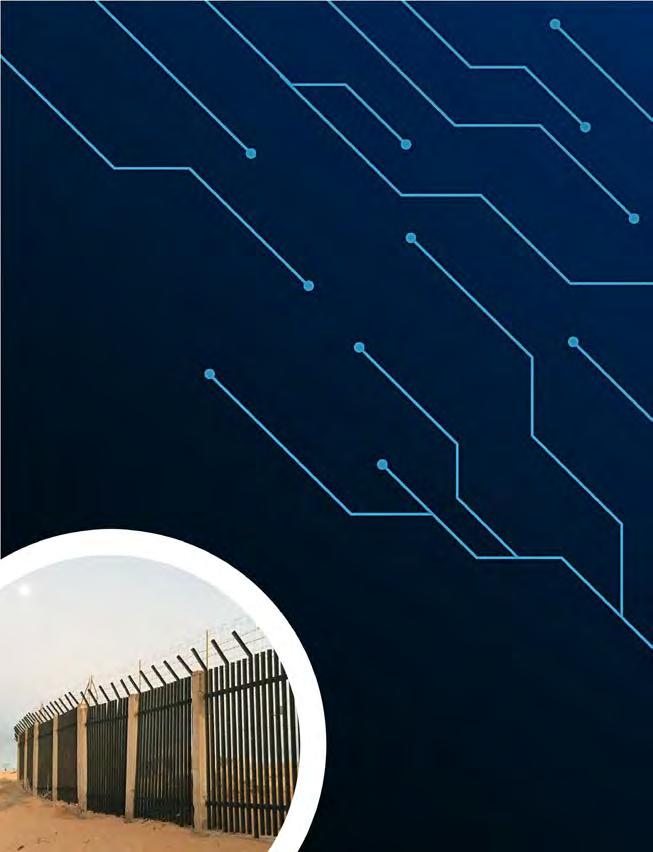

08 - 09
October 2024
Venue: Oman Convention & Exhibition Centre Muscat, Sultanate Of Oman
12-14 October 2020


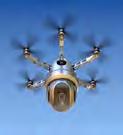
Time: 11am to 8pm
Venue: Oman Convention & Exhibition Centre Muscat, Sultanate Of Oman


























ISNR Abu Dhabi
21-23 May 2024, Abu Dhabi, UAE
https://isnrabudhabi.com

Security Essen
Key Security Events in 2023

Integrate Middle East
21-23 May 2024, Dubai, UAE
https://www.integrateme.com
17-20 September 2024, Essen, Germany
https://www.security-essen.de

OFSEC, Oman

Intersec Saudi Arabia
1-3 October 2024, Riyadh, KSA
8-9 October 2024, Muscat, Sultanate of Oman
https://www.ofsecevent.com

ISAF Fuari
10-13 October 2024, Istanbul, Turkey
https://www.isaffuari.com
https://intersec-ksa.ae.messefrankfurt.com/ ksa/en.html
Adria Security Summit Powered by Intersec 9-10 October 2024, Sarajevo, Bosnia and Herzegovina
https://www.adriasecuritysummit.com
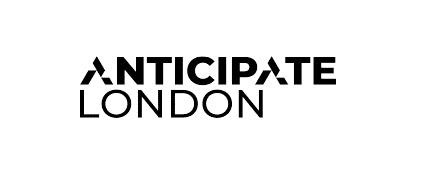
ANTICIPATE LONDON
2-4 December 2024, London, UK
https://www.anticipate-event.com/londo.../ home.html

The Middle East and North Africa premier forum and sourcing platform for the global Pro AV Community, connecting technology leaders with integrated solution buyers from the intersecting worlds of Education, Retail, Hospitality, Media, Metaverse, Entertainment, Real Estate, Communications and much more.
Bosch
Vendor-neutral Physical Security Information Management (PSIM)
Advancis Middle East
P.O. Box 73309
Abu Dhabi, United Arab Emirates
Tel. +971 2 444 2503
Email: info@advancis.ae
Web: https://advancis.net



United Arab Emirates Qatar Egypt Saudi Arabia info.me.open@assaabloy.com www.assaabloy.com/ae



Man Guarding
Technical protection
• Video surveillance
• Access control
• Intrusion detection
• Item theft protection
• IP and network solutions
• Perimeter protection
• Fire detection
• Gas detection
Mechanical protection Cash/valuables-in-transit
Cyber security
Digital forensics
Software solutions
Smart home
Internet of things
Security management
Investigations
Building management
Market research
Legislation and standards
Honeywell Commercial Security offers integrated security solutions within:
* Video Surveillance * Access Control * Intruder Detection both as standard and cloud based systems. Contact:
Dubai: +971 4 4505 800 Abu Dhabi: +971 2 2349 101 https://www.honeywell.com/ae

m.shenawy@supremainc.com)
Tel: +971 4 2357 996 www.supremainc.com
www.saltohospitality.com
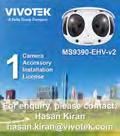


Technical
•
•
•
•
•
•
•
•
Cyber
Software
Smart
Internet
Security
Building
Market
Legislation




Improve security standards through the implementation of laws, standards and international best practices in security systems as well as security management and guarding services.

SIRA now has more than 60,000 members working within the Dubai security industry, with the agency’s laws and guidelines helping to ensure that standards are continuously kept high
